Tropical rainforests are one of the most diverse habitats in the world, consisting of a unique set of flora and fauna that can only be found in this region.
One of the important groups of animals that live in this habitat are birds. The tropical rainforest is home to about 14% of the world’s bird species – a staggering number given that this habitat only covers about 6% of the Earth’s surface.
These birds are not only stunning in their appearance, but they also play crucial roles in maintaining the health of the ecosystem through their interactions with other organisms.
In this article, we will explore the diverse range of bird species found in the tropical rainforest, and delve into their unique adaptations, behaviors, and importance.
1. Kingfisher
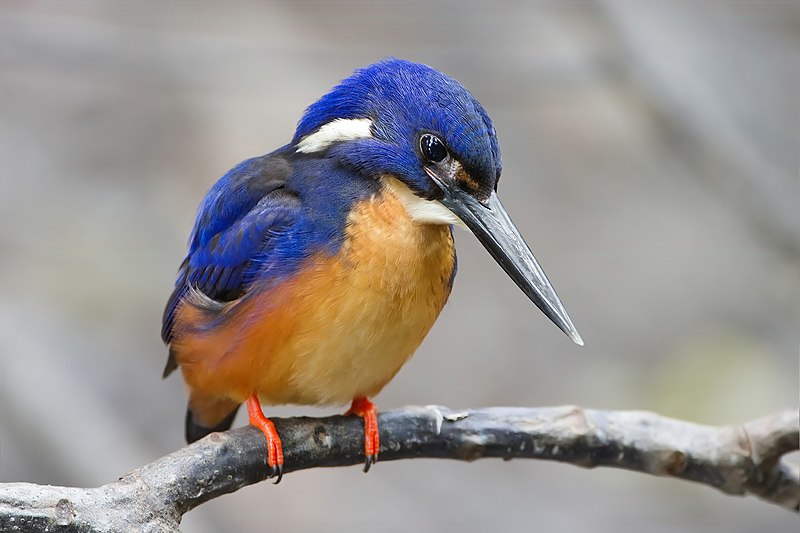
Kingfishers are a vibrant and unique family of birds, with most species found in tropical regions across Africa, Asia, Oceania and Europe.
Their bright colors make them easily identifiable among the foliage of deep forests near calm ponds or rivers.
They come in three subfamilies: tree kingfishers (Halcyoninae), water kingfishers (Cerylinae) and river kingfishers (Alcedinidae).
Kingfisher birds have short legs used for perching along branches overhanging streams or lakes; they also possess strong beaks perfect for catching fish.
These little hunters will remain motionless as if suspended from thin air until an unsuspecting prey comes within reach.
Then they swoop down quickly to grab their meal. With 116 different species making up this incredible family, there’s something special about every single one.Scientific classification:
| Kingdom | Animalia |
| Phylum | Chordata |
| Class | Aves |
| Order | Coraciiformes |
| Suborder | Alcedines |
| Family | Alcedinidae Rafinesque, 1815 |
Also Featured In: Common Birds in India, Birds You’ll Find in Moldova
2. Birds-Of-Paradise
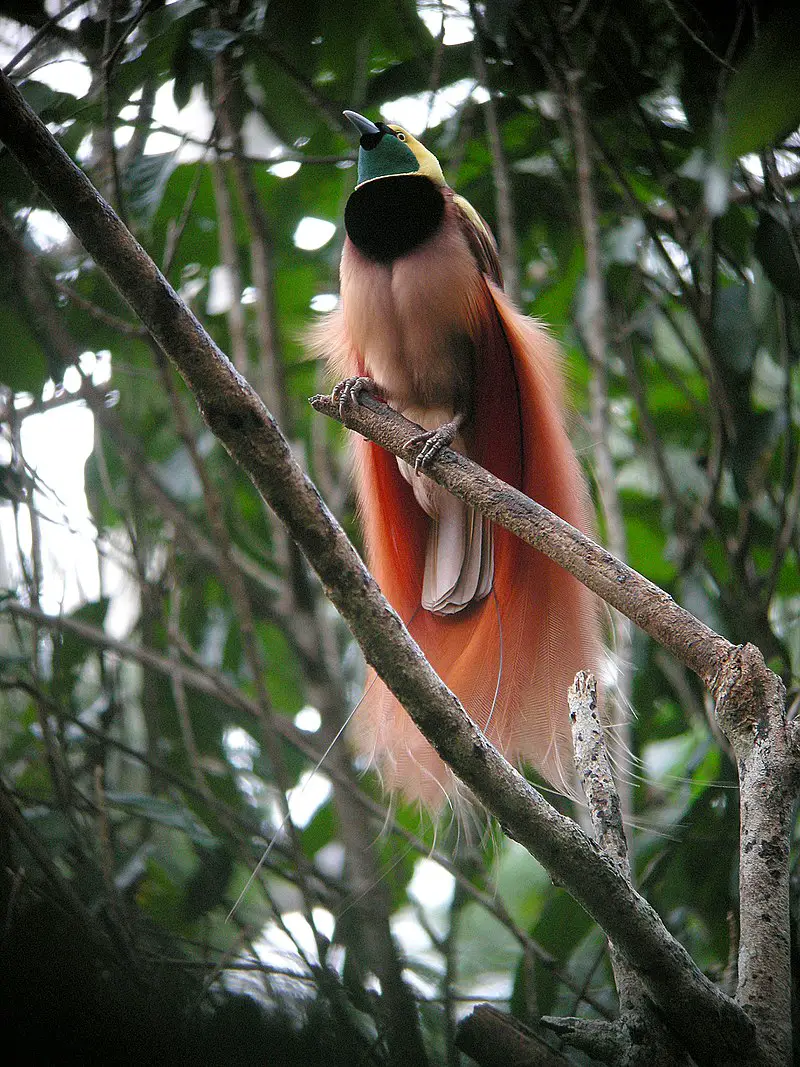
The birds-of-paradise are a family of passerines found mainly in eastern Indonesia, Papua New Guinea and eastern Australia.
These fascinating creatures have 45 species divided into 17 genera and are best known for their vibrant plumage.
Males of the species tend to be more colourful than females, with bright colours such as reds, blues and greens often seen on their feathers.
Their elaborate courtship displays also make them quite unique among other birds; they use various visual cues to attract mates including plumes, tail feathers and even dances.
The diversity of these stunning creatures makes them one of the most captivating bird families in existence today.Scientific classification:
| Kingdom | Animalia |
| Phylum | Chordata |
| Class | Aves |
| Order | Passeriformes |
| Superfamily | Corvoidea |
| Family | Paradisaeidae Swainson, 1825 |
Also Featured In: Beautiful Indonesian Birds,
3. Toco Toucan
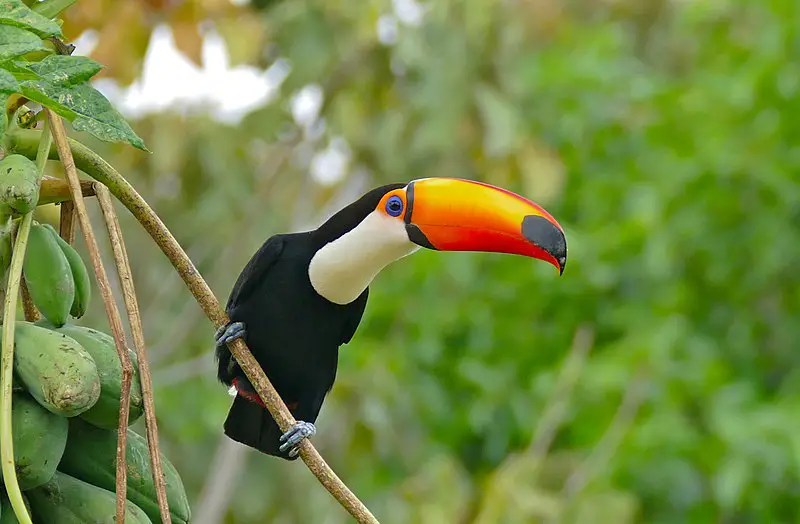
The Toco Toucan is the largest and most recognizable species of toucans, native to semi-open habitats in Central and Eastern South America.
First described by German zoologist Philipp Ludwig Statius Müller in 1776, this colorful bird has two subspecies – Ramphastos toco toco and Ramphastos toco cuvieri – distinguished by their slightly different size, plumage coloration, beak markings and range.
With its large orange bill covered with black spots along the sides of its face contrasting with yellow feathers on top of its head , it’s a very striking animal indeed.
Commonly found in zoos around the world too due tot heir loveable nature they are often kept as pets. They feed mainly on fruit but may also eat insects or small reptiles from time to time.
All in all these birds provide us a wonderful spectacle that we should appreciate for many years ahead.Scientific classification:
| Kingdom | Animalia |
| Phylum | Chordata |
| Class | Aves |
| Order | Piciformes |
| Family | Ramphastidae |
| Genus | Ramphastos |
| Species | R. toco |
Also Featured In: Beautiful Brazilian Birds, Most Common Birds in South America Birds
4. Toucans
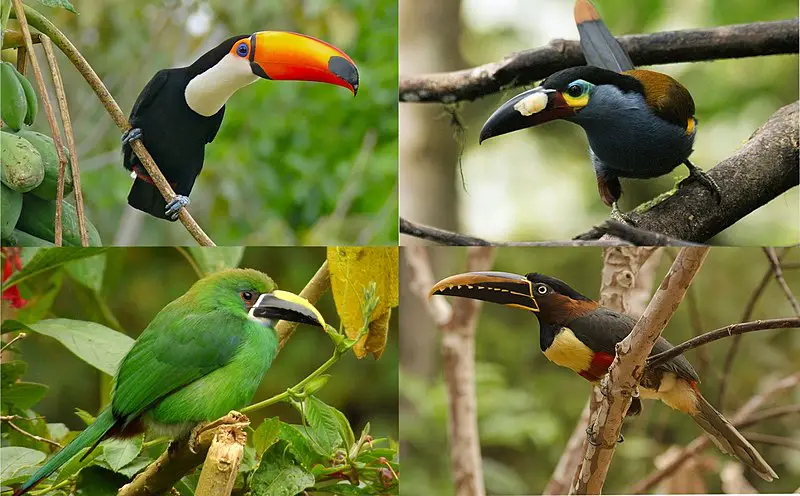
Toucans are members of the Ramphastidae family, which is closely related to American barbets. These birds have brightly-colored feathers and large beaks that come in a variety of colors.
They tend to live high up in trees, where they make their nests with two or four white eggs inside.
Toucans typically feed on fruits and sometimes small insects as well. Some species can even catch larger animals such as reptiles and amphibians for food.
Although toucans like to keep close together when living in groups, during breeding season they become more aggressive towards each other due to competition over resources like nesting sites or food sources.Scientific classification:
| Kingdom | Animalia |
| Phylum | Chordata |
| Class | Aves |
| Order | Piciformes |
| Infraorder | Ramphastides |
| Family | Ramphastidae Vigors, 1825 |
Also Featured In: Famous Paintings Birds,
5. Hyacinth Macaw
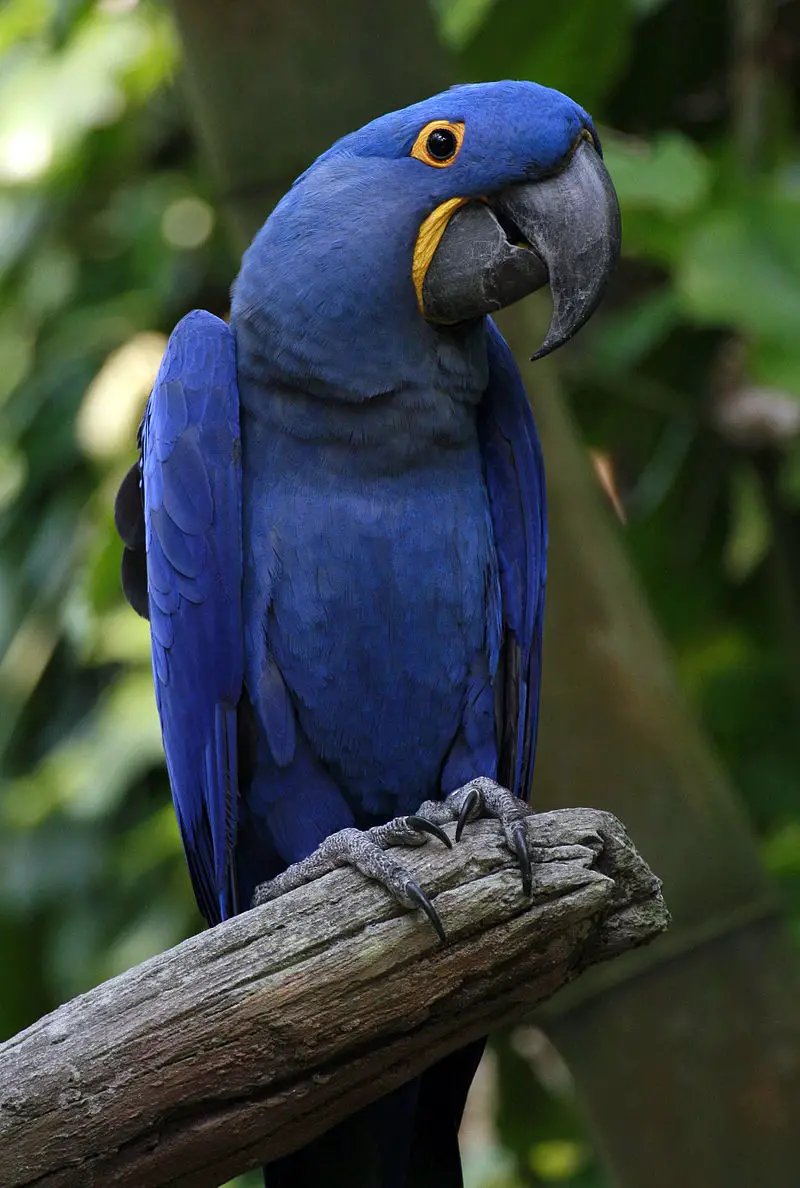
The Hyacinth Macaw is an extraordinary bird, known for its impressive size and vibrant coloration.
It has a length of around one meter, making it the longest parrot species in existence as well as the largest flying parrot species; even larger than 3.5 kg flightless Kākāpō from New Zealand.
Its striking blue plumage with yellow at its wingtips gives this majestic bird an eye-catching appearance that’s sure to turn heads wherever it goes.
Native to central and eastern South America, these birds are highly intelligent creatures who form strong bonds with their owners when kept in captivity.
They make great companions if given proper care and attention which includes providing them with plenty of space for exercise and enrichment activities such as playtime out of the cage on occasion or teaching them tricks using positive reinforcement methods like verbal praise or food rewards.Scientific classification:
| Kingdom | Animalia |
| Phylum | Chordata |
| Class | Aves |
| Order | Psittaciformes |
| Family | Psittacidae |
| Genus | Anodorhynchus |
| Species | A. hyacinthinus |
Also Featured In: Blue Birds You’ll Found around Us, Common Latin America Birds
6. Scarlet Macaw
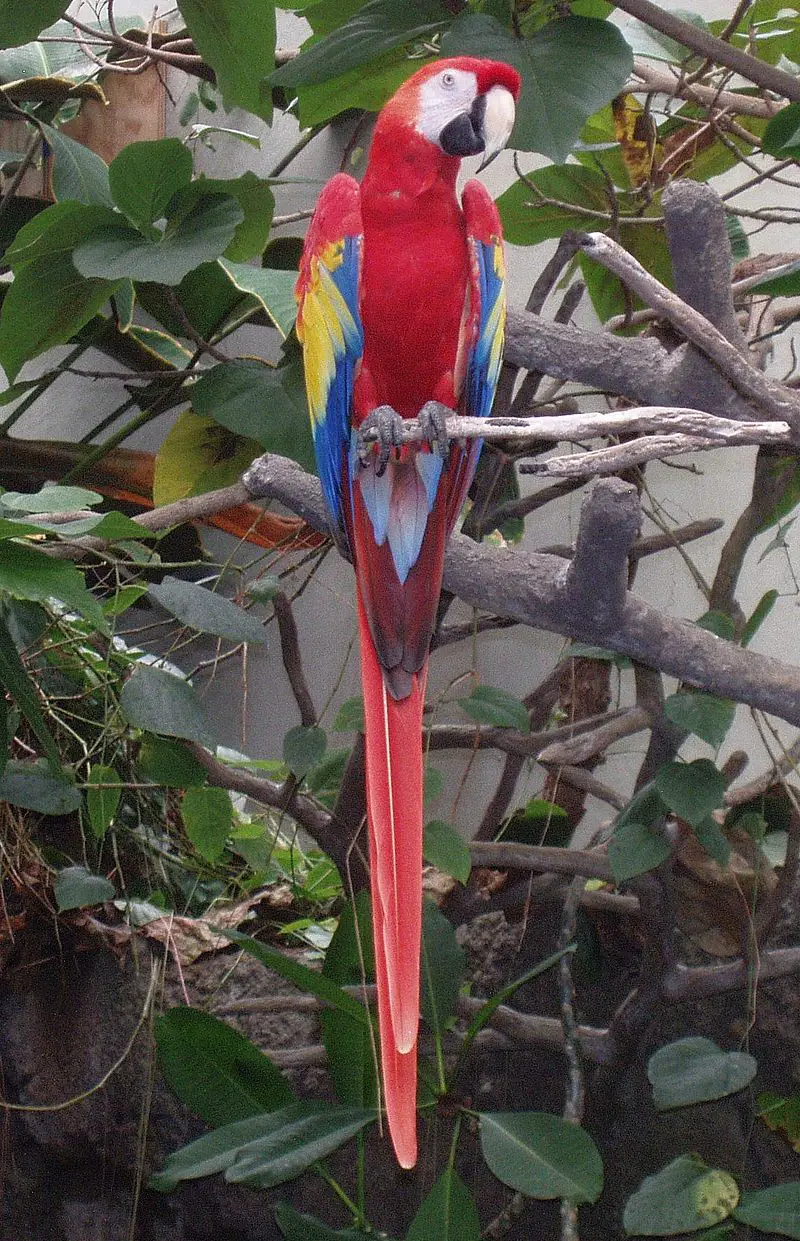
The Scarlet Macaw is a vibrant and beautiful bird found in Central and South America. Its striking red, yellow, and blue feathers make it stand out among other parrots.
It inhabits humid evergreen forests of the Neotropics from Mexico to Peru, Ecuador, Colombia, Bolivia Venezuela Brazil up to an altitude of 1000m (3300ft).
These birds have strong beaks which they use for breaking open hard nuts or seeds that would otherwise remain inaccessible.
They also form social bonds with their mates by grooming eachothers’ feathers and engaging in playful activities such as chasing one another around tree trunks.
Despite its vivid colors the Scarlet Macaw remains vulnerable due to habitat loss caused by deforestation so conservation efforts are essential if this amazing species is going to survive for future generations.Scientific classification:
| Kingdom | Animalia |
| Phylum | Chordata |
| Class | Aves |
| Order | Psittaciformes |
| Family | Psittacidae |
| Genus | Ara |
| Species | A. macao |
Also Featured In: Spiritual Birds, Case Birds that Live in with Us
7. Hoatzin
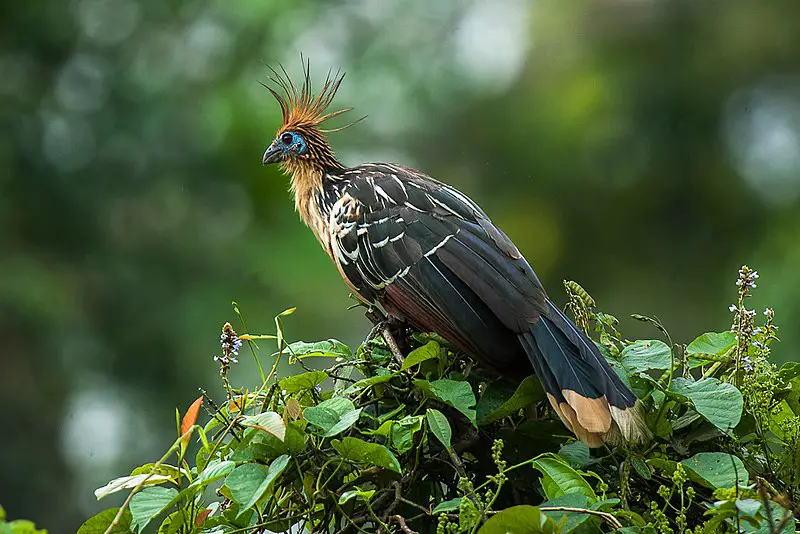
The Hoatzin bird is a tropical species found in the Amazon and Orinoco river basins of South America. It inhabits swamps, riparian forests and mangroves.
This unique bird has chicks that have claws on two of their wing digits which make it the only member in its order – Opisthocomiformes.
Its most distinctive feature is an odour produced from its digestive system which smells like cow manure.
The adults are brownish-grey with blue facial skin, red eyes, pointed crest feathers and black primaries.
They feed mainly on leaves but also eat flowers, fruits or buds when available during different seasons.
They can be heard making loud calls resembling caws at night time as well as repeated whistles throughout the day to keep contact between family members within flocks.Scientific classification:
| Kingdom | Animalia |
| Phylum | Chordata |
| Class | Aves |
| Order | Opisthocomiformes |
| Family | Opisthocomidae |
| Genus | Opisthocomus Illiger, 1811 |
| Species | O. hoazin |
Also Featured In: Birds that Live in Guyana,
8. Amazon Kingfisher
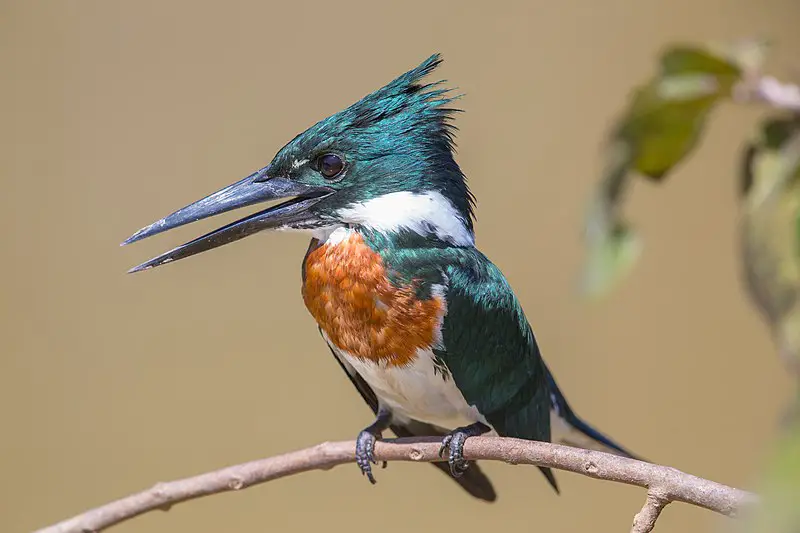
The Amazon Kingfisher is a stunning species of water kingfisher found in the lowlands of Central and South America.
It has an aqua-green head, chestnut wings with white markings, blue back and tail and yellow feet.
Its dramatic plumage makes it one of the most attractive birds in its region.
The Amazon Kingfisher can be seen perching on branches or flying close to slow moving rivers while they search for food such as fish, frogs, lizards or insects which they catch by diving into the water from above.
Despite their colorful appearance these bird are incredibly shy so it’s difficult to get too close without scaring them away.Scientific classification:
| Kingdom | Animalia |
| Phylum | Chordata |
| Class | Aves |
| Order | Coraciiformes |
| Family | Alcedinidae |
| Subfamily | Cerylinae |
| Genus | Chloroceryle |
| Species | C. amazona |
Also Featured In: Birds that You’ll Find in Chiapas, Most Common Oaxaca Birds
9. Blue-And-Yellow Macaw
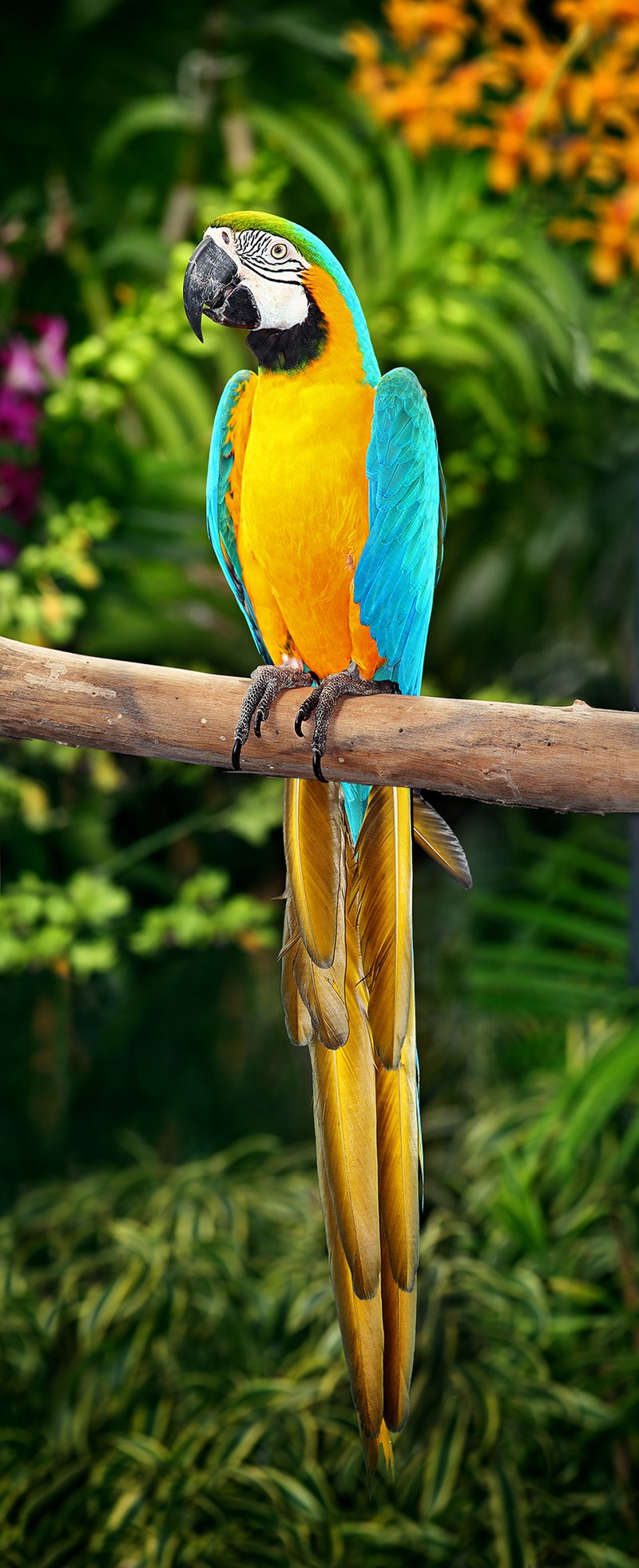
The Blue-and-yellow Macaw is a vibrant and eye catching bird native to South America. It has beautiful blue top parts, light orange underparts, and green on its head.
This large parrot lives in the tropical forests of varzea, terra firme or unflooded forest areas.
They are social birds that live in small flocks which can range from two to twenty birds during breeding season when they look for mates.
They feed mainly on seeds, nuts and fruits but sometimes also eat insects like beetles and caterpillars as well as tender shoots from trees & plants.
These macaws have an impressive call with loud screams used both to attract mates and communicate between members of their flock while flying long distances across open fields together.Scientific classification:
| Kingdom | Animalia |
| Phylum | Chordata |
| Class | Aves |
| Order | Psittaciformes |
| Family | Psittacidae |
| Genus | Ara |
| Species | A. ararauna |
Also Featured In: Pet Birds that Live in India,
10. Turaco
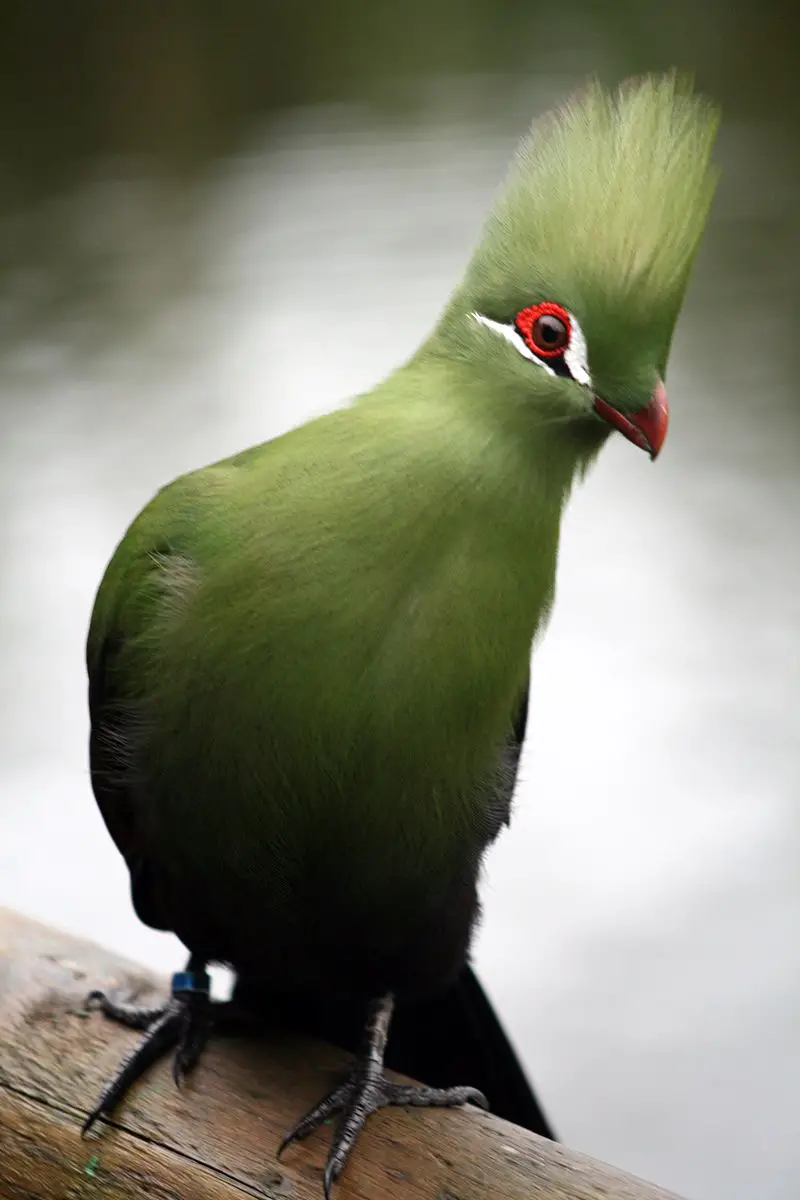
Turacos are a unique bird family that inhabit tropical and subtropical regions of Africa. They are also known as “banana-eaters” or “loeries” in southern Africa, due to their diet which consists mostly of fruit such as plantains.
These birds have an interesting semi-zygodactylous foot structure – the fourth toe can be switched back and forth while the second and third toes remain conjoined.
Turacos come in different sizes depending on species but they all generally boast bright colors like green, blue, purple or red feathers with vibrant yellow eyes.
In addition to being beautiful creatures, these birds make loud calls during mating season which makes them even more special.Scientific classification:
| Kingdom | Animalia |
| Phylum | Chordata |
| Class | Aves |
| Clade | Otidimorphae |
| Order | Musophagiformes Seebohm, 1890 |
| Family | Musophagidae Lesson, 1828 |
Also Featured In: Common Nigerian Birds, Native Birds of Equatorial Guinea
11. Hornbill
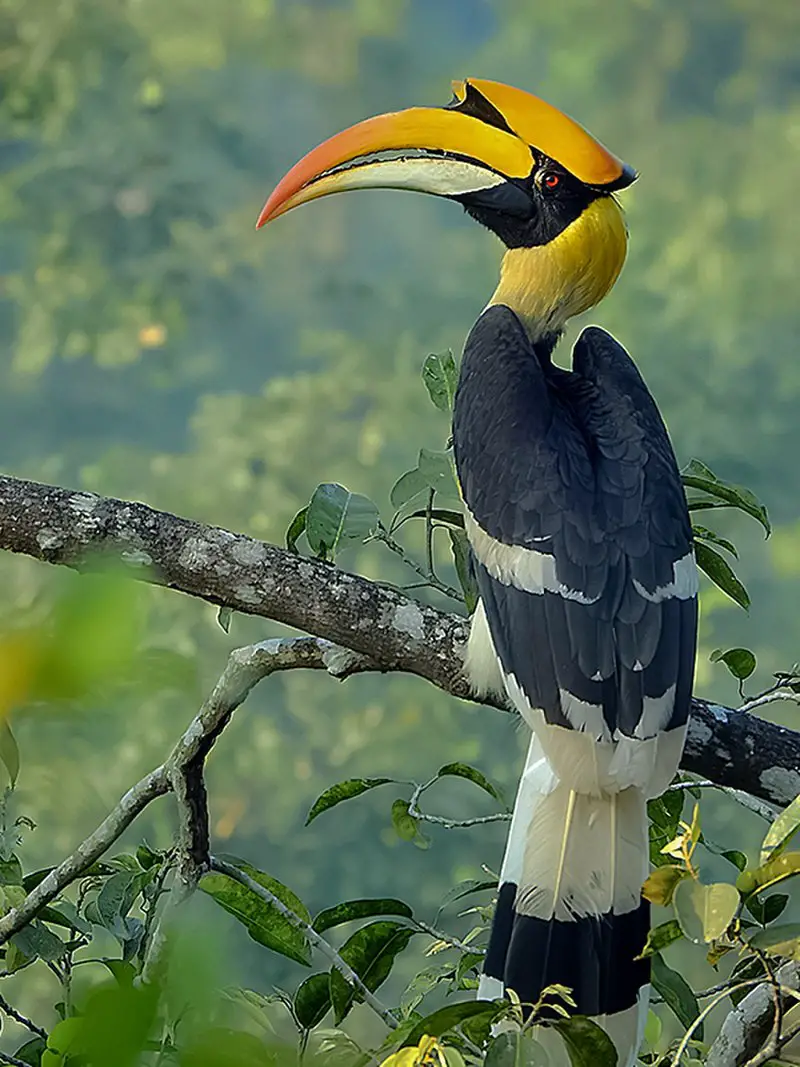
Hornbills are a tropical and subtropical bird species with characteristic long, curved bills. Their English and scientific names both refer to the shape of their bill which resembles that of a cow’s horn.
They have strong beaks for cracking open hard-shelled fruits as well as powerful wings for flying between trees or over great distances in search of food or mates.
Hornbills also feature beautiful plumage ranging from white to black feathers with yellow, brown, red and blue accents on the head, neck and back areas depending on the species.
In addition they often display brightly coloured casques – helmet like structures – atop their upper mandible adding further visual appeal to these majestic birds.Scientific classification:
| Kingdom | Animalia |
| Phylum | Chordata |
| Class | Aves |
| Order | Bucerotiformes |
| Family | Bucerotidae Rafinesque, 1815 |
Also Featured In: Birds of South African, African Birds
12. Great Hornbill
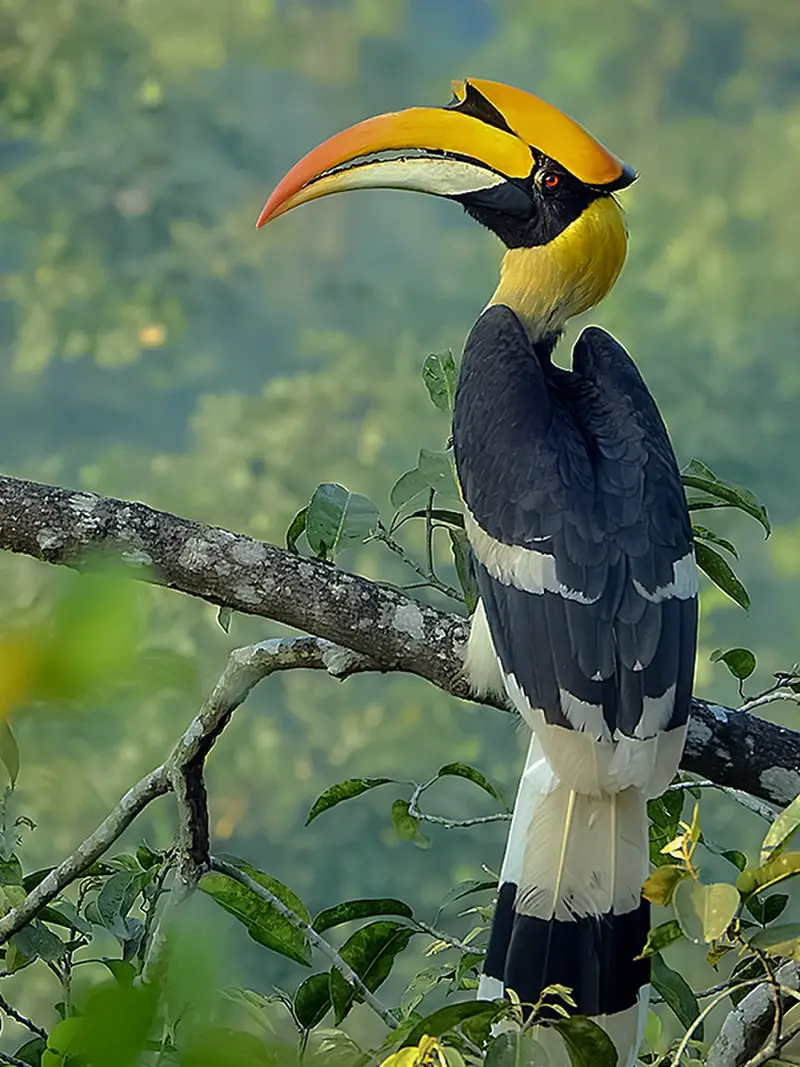
The Great hornbill is an impressive bird, belonging to the family of Hornbills. It can be found in India and Southeast Asia, mainly eating fruits but also preying on small mammals, reptiles and birds.
Its striking looks include a concave casque which sits atop its head as well as vibrant yellow-orange feathers covering much of its body.
Unfortunately it’s listed by IUCN Red List since 2018 due to habitat loss resulting from deforestation for agriculture and timber logging activities taking place across the world today.
Despite this sad news there are still conservation measures being taken such as education programs focusing on sustainable farming practices that will help protect this amazing species’ future.Scientific classification:
| Kingdom | Animalia |
| Phylum | Chordata |
| Class | Aves |
| Order | Bucerotiformes |
| Family | Bucerotidae |
| Genus | Buceros |
| Species | B. bicornis |
Also Featured In: Birds of Myanmar, Common Birds in Kerala
13. Wreathed Hornbill
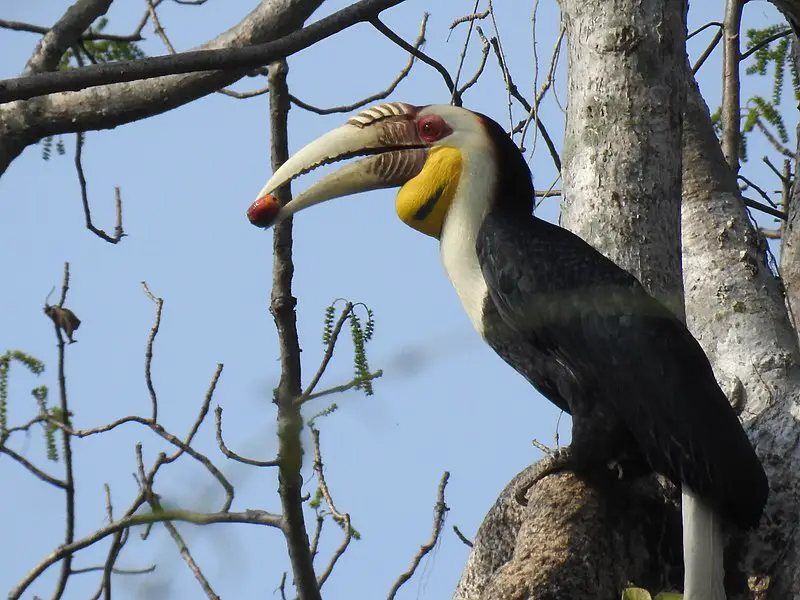
The Wreathed Hornbill is a magnificent bird found in the Old World tropics. It has an unmistakable curved bill that develops ridges, or wreaths, on its upper mandible as it matures.
The male of this species is black with a rufous crown and white underparts while females are mostly brownish-black all over.
On their lower throat sacs they have an eye-catching blue-black band which gives them their other name – Bar-pouched Wreathed Hornbills.
These birds mainly feed on fruits but also enjoy insects sometimes too. They nest inside tree hollows lined with mud and feathers to keep the eggs safe from predators and weather elements alike.
Though threatened by habitat loss due to deforestation, these beautiful creatures can still be seen flying around forests across Southeast Asia today.Scientific classification:
| Kingdom | Animalia |
| Phylum | Chordata |
| Class | Aves |
| Order | Bucerotiformes |
| Family | Bucerotidae |
| Genus | Rhyticeros |
| Species | R. undulatus |
14. Andean Cock-Of-The-Rock
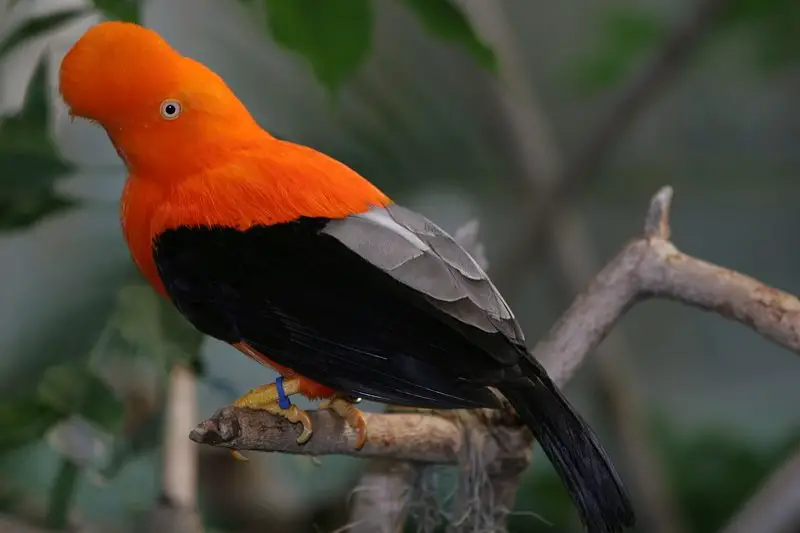
The Andean cock-of-the-rock is a large passerine bird belonging to the Cotinga family. It has four subspecies and can be found in the cloud forests of South America, notably Peru where it has been declared its national bird.
This species exhibits marked sexual dimorphism; males have an impressive orange crest that covers most of their head as well as a bright coral chest patch while females are mainly grey with dark wings and tail feathers.
Both sexes also feature black heads, yellow eyes, long bills and short legs.
Their diet consists mostly of fruits but they have also been known to eat small insects for protein.
They are monogamous birds who mate for life forming strong pair bonds that last several years until one partner dies or moves away from its territory.Scientific classification:
| Kingdom | Animalia |
| Phylum | Chordata |
| Class | Aves |
| Order | Passeriformes |
| Family | Cotingidae |
| Genus | Rupicola |
| Species | R. peruvianus |
Also Featured In: Common Birds in Colombia,
15. Keel-Billed Toucan
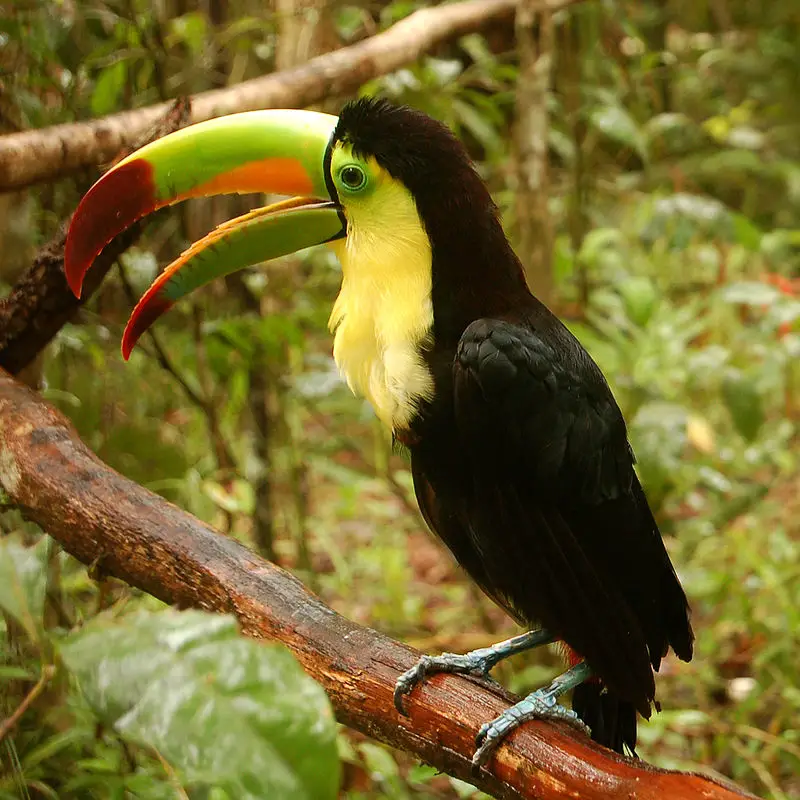
The Keel-billed Toucan is a vibrant Latin American bird from the toucan family and also serves as Belize’s national bird. They are found in tropical jungles stretching all the way from southern Mexico to Colombia.
They feed on fruits, seeds, insects, lizards and snakes – being omnivorous birds they eat pretty much anything.
These colourful creatures have an impressive beak with green upper parts of their bodies coupled with yellow lower halves.
The underside of their tail feathers are black while its tips remain white creating for quite a stunning display when flying or perched atop tree branches.Scientific classification:
| Kingdom | Animalia |
| Phylum | Chordata |
| Class | Aves |
| Order | Piciformes |
| Family | Ramphastidae |
| Genus | Ramphastos |
| Species | R. sulfuratus |
16. King Vulture
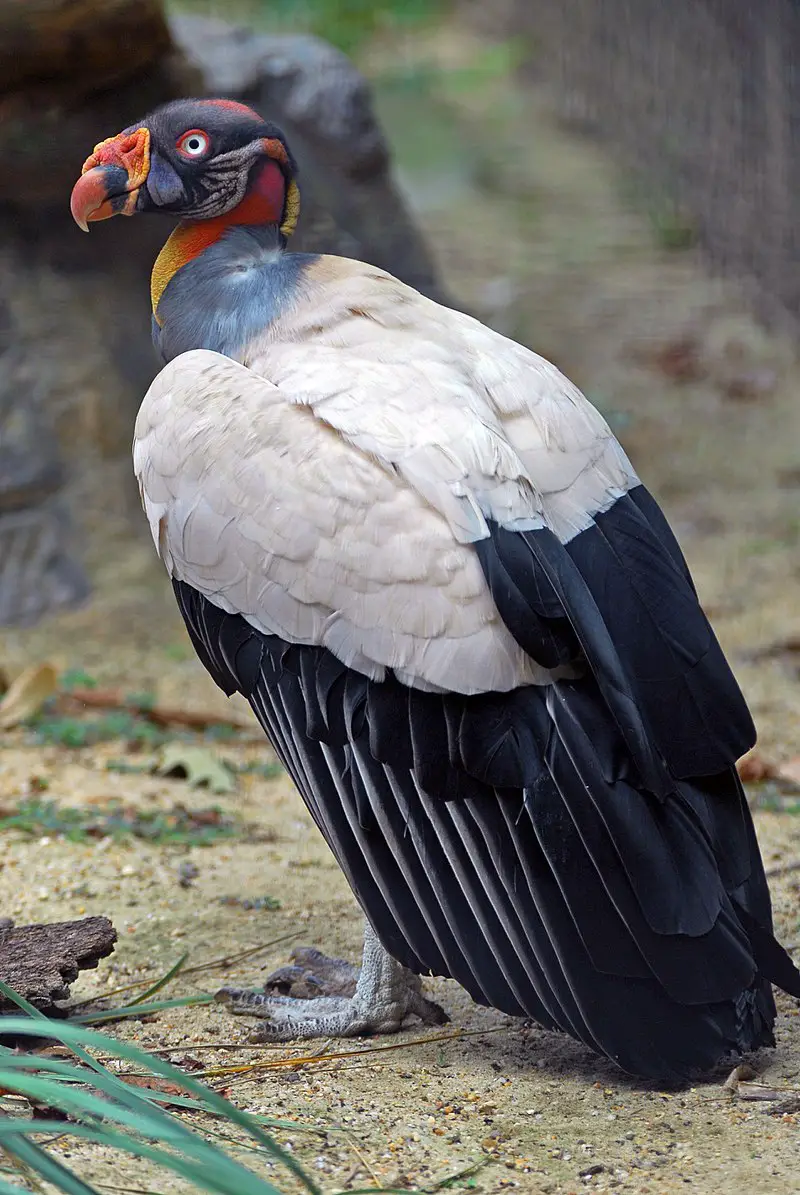
The King Vulture is a majestic bird found in Central and South America. It has striking white plumage with black accents, and its head is topped by a bright yellow crest.
With long wingspan of up to 4 feet, this vulture soars gracefully through the sky. Its large size allows it to dominate other scavenging birds at carcasses; although not as powerful as some raptors, the king vulture will protect what belongs to it fiercely.
The diet of these elegant creatures consists mainly of carrion such as dead mammals or fish that they spot from far away using their excellent vision.
They also occasionally eat eggs or nestlings if food is scarce during dry seasons.
This fascinating species plays an important role in keeping ecosystems healthy by removing dead animals from landscapes quickly before diseases spread further into populationsScientific classification:
| Kingdom | Animalia |
| Phylum | Chordata |
| Class | Aves |
| Order | Accipitriformes |
| Family | Cathartidae |
| Genus | Sarcoramphus |
| Species | S. papa |
Also Featured In: Scavengers Birds You Should Know, Common Carnivore Birds
17. Harpy Eagle
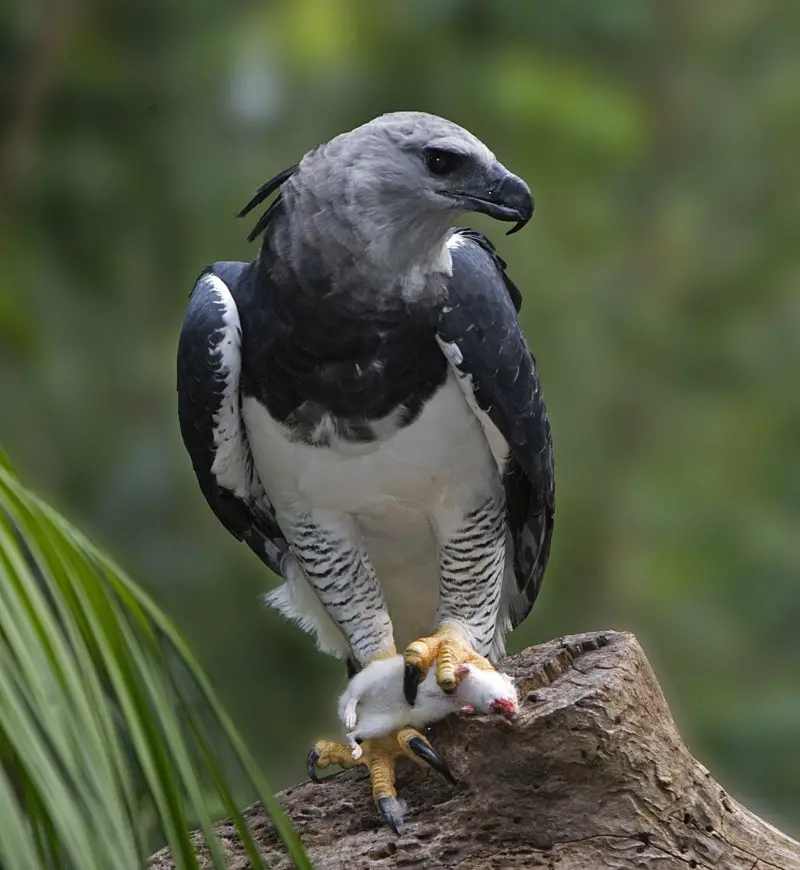
The Harpy Eagle is a magnificent bird of prey found in the tropical forests of Central and South America. It is the largest eagle on Earth, possessing an impressive wingspan that can reach up to 7 feet across.
Its powerful talons are its most distinguishing feature, being able to grasp even large animals such as monkeys or sloths with ease.
The majestic raptor has slate-gray feathers on its back and head which contrast against white undersides and yellow legs.
These birds live alone for much of their life but will come together during breeding season when they construct elaborate nests high off the ground in tall trees.
People have long been fascinated by this species’ impressive size and strength—it truly deserves its nickname as “the lord of skies”.Scientific classification:
| Kingdom | Animalia |
| Phylum | Chordata |
| Class | Aves |
| Order | Accipitriformes |
| Family | Accipitridae |
| Subfamily | Harpiinae |
| Genus | Harpia Vieillot, 1816 |
| Species | H. harpyja |
18. Chocolate-Backed Kingfisher
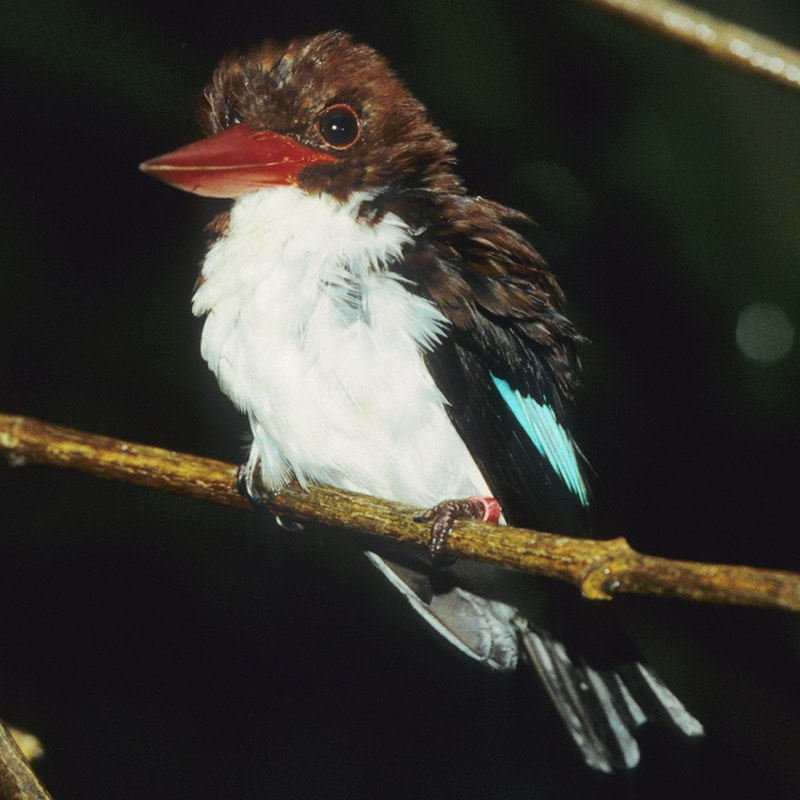
The Chocolate-backed Kingfisher is a beautiful sight to behold. It has dark upperparts and pure white underparts, as well as a black head and hind neck, brownish-black mantle, and brilliant iridescent blue rump.
This species of kingfisher can be found in western Sub-Saharan Africa where it usually inhabits open woodland or savanna habitats near water bodies like rivers or marshes.
They are solitary birds that feed on small fish they catch by diving into the water from an elevated perch.
These stunning birds also perform elaborate courtship displays consisting of aerial acrobatics while making loud calls to attract potential mates during breeding season.Scientific classification:
| Kingdom | Animalia |
| Phylum | Chordata |
| Class | Aves |
| Order | Coraciiformes |
| Family | Alcedinidae |
| Subfamily | Halcyoninae |
| Genus | Halcyon |
| Species | H. badia |
Also Featured In: Uganda Birds Species,
19. Grey-Winged Trumpeter
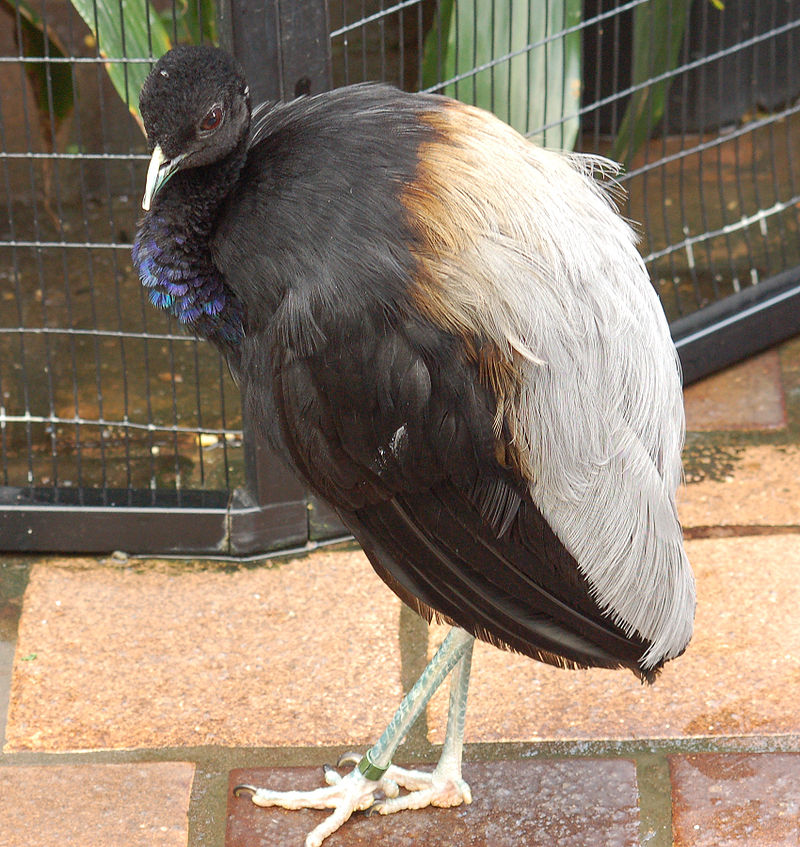
The Grey-winged Trumpeter is a species of bird found in South America, spanning Brazil, Colombia, Ecuador and several other countries.
It belongs to the small family Psophiidae and has an uncertain taxonomy; this is being studied by various organisations such as the International Ornithological Committee (IOC).
They are usually around 35 cm long with grey wings and brown eyes. This species typically lives in humid lowland forests or adjacent woodlands.
Its diet consists mainly of fruits, seeds and some invertebrates which it finds on the ground or near trees.
The mating season for these birds occurs from October to February when they build nests made out of twigs lined with leaves close to their food sources for protection against potential predators.
Although not currently threatened due to its wide range distribution across multiple countries there may be localised threats that need monitoring in order for them survive into future generations.Scientific classification:
| Kingdom | Animalia |
| Phylum | Chordata |
| Class | Aves |
| Order | Gruiformes |
| Family | Psophiidae |
| Genus | Psophia |
| Species | P. crepitans |
Also Featured In: Most Unique Birds in Peru,
20. Red-Billed Dwarf Hornbill
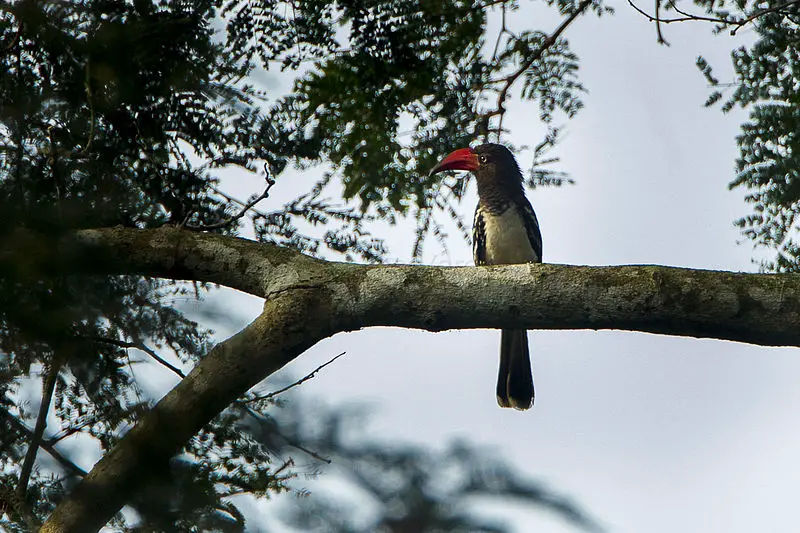
The red-billed dwarf hornbill is a species of bird found in the African tropical rainforest. It belongs to the Bucerotidae family and has a striking appearance, with its bright red bill contrasting against mainly black feathers.
Its wings are long and pointed, helping it to fly through dense vegetation quickly. The diet of this small hornbill consists mostly of insects, fruit and seeds.
They live both solitarily or in pairs but may form larger flocks during breeding season when they search for mates together.
These birds build their nests high up into tree hollows where they lay their eggs before taking turns incubating them until hatching occurs – an amazing example of teamwork.
Red-billed dwarf hornbills really are remarkable creatures that help keep natural ecosystems balanced throughout Africa’s lush forests; we should all do our part in protecting these majestic animals from extinction so future generations can appreciate them too.Scientific classification:
| Kingdom | Animalia |
| Phylum | Chordata |
| Class | Aves |
| Order | Bucerotiformes |
| Family | Bucerotidae |
| Genus | Lophoceros |
| Species | L. camurus |
Also Featured In: Common Birds In Ghana,
21. Guianan Cock-Of-The-Rock
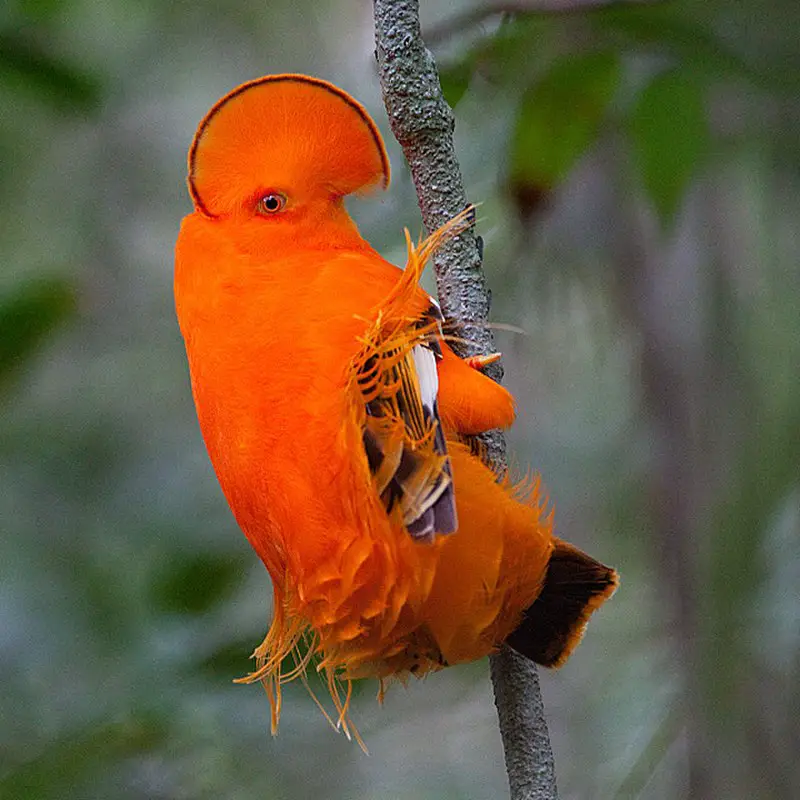
The Guianan cock-of-the-rock is an impressive South American bird, with the male having a striking orange and black plumage.
This cotinga species can be found in tropical rainforests near rocky outcrops, usually measuring about 30 cm (12 in) long and weighing around 200 to 220 g (7.1 to 7.8 oz).
The female’s feathers are brownish/dark smokey grey – generally less noticeable than the males due to their bright colours.
These birds have also been known for their unusual courtship displays involving loud calling and bowing which take place on exposed rocks or branches of tall trees.
Their diet consists mainly of fruits supplemented by invertebrates such as insects, spiders, millipedes and centipedes that they capture while flying through the canopy layer.
All in all, these beautiful creatures will make sure you never forget them after seeing one.Scientific classification:
| Kingdom | Animalia |
| Phylum | Chordata |
| Class | Aves |
| Order | Passeriformes |
| Family | Cotingidae |
| Genus | Rupicola |
| Species | R. rupicola |
Also Featured In: Birds of Venezuela,
22. Chestnut-Eared Aracari
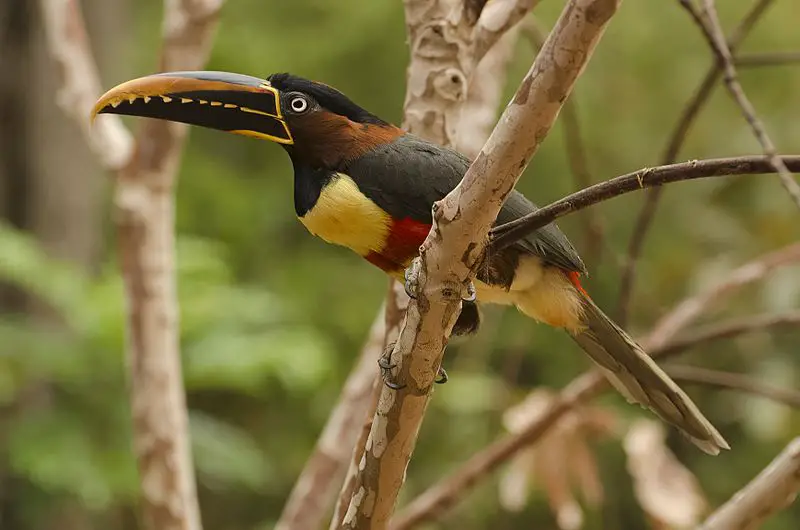
The Chestnut-eared Aracari is a beautiful near-passerine bird found in Argentina, Bolivia, Brazil, Colombia, Ecuador Paraguay and Peru. It has two subspecies – the nominate Pteroglossus castanotis and P.
c australis – both of which have bright chestnut colored feathers at their ears that really stand out against its mostly black body plumage.
The average size for this species is 43 cm (17 inches) long but can reach up to around 48 cm (19 inches).
They are known to be quite vocal birds with loud calls being heard during flight or while they feed on fruits at canopy level as they hop from branch to branch using their strong feet and curved bills.
This stunning creature will always capture attention due to its bold colors making it a real delight for any nature lover.Scientific classification:
| Kingdom | Animalia |
| Phylum | Chordata |
| Class | Aves |
| Order | Piciformes |
| Family | Ramphastidae |
| Genus | Pteroglossus |
| Species | P. castanotis |
Also Featured In: Birds of Bolivia,
23. Great Green Macaw
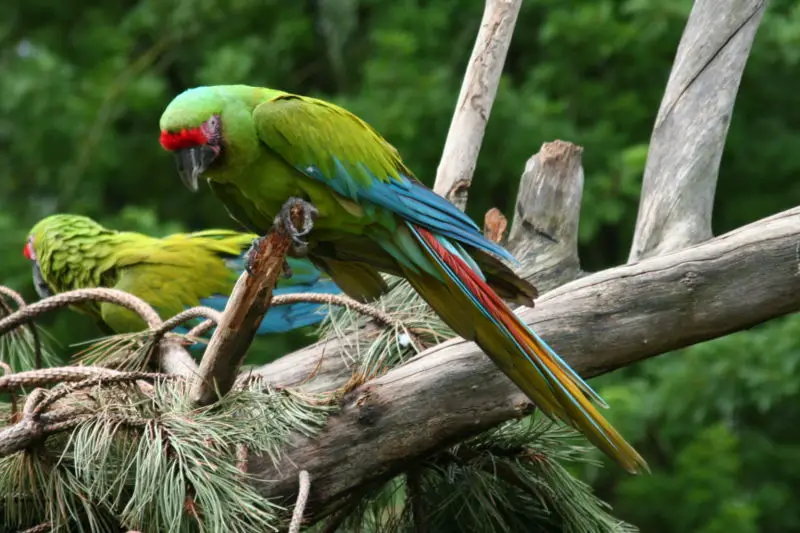
The great green macaw is a beautiful Central and South American parrot that can be found from Honduras to Colombia as well as Nicaragua, Costa Rica, Panama, and Ecuador.
With its bright red forehead, yellow cheeks and blue wings it’s easy to spot in the wild.
This magnificent bird has two recognized subspecies; Ara ambiguus ssp. ambiguus which ranges across most of its range while Ara ambiguus ssp. guayaquilensis appears exclusive to northwestern Ecuador.
These birds are usually seen foraging for seeds but their diet also includes fruits such as figs or palm nuts making them an important part of tropical ecosystems.Scientific classification:
| Kingdom | Animalia |
| Phylum | Chordata |
| Class | Aves |
| Order | Psittaciformes |
| Family | Psittacidae |
| Genus | Ara |
| Species | A. ambiguus |
Also Featured In: Birds of Honduras,
24. Northern Cassowary
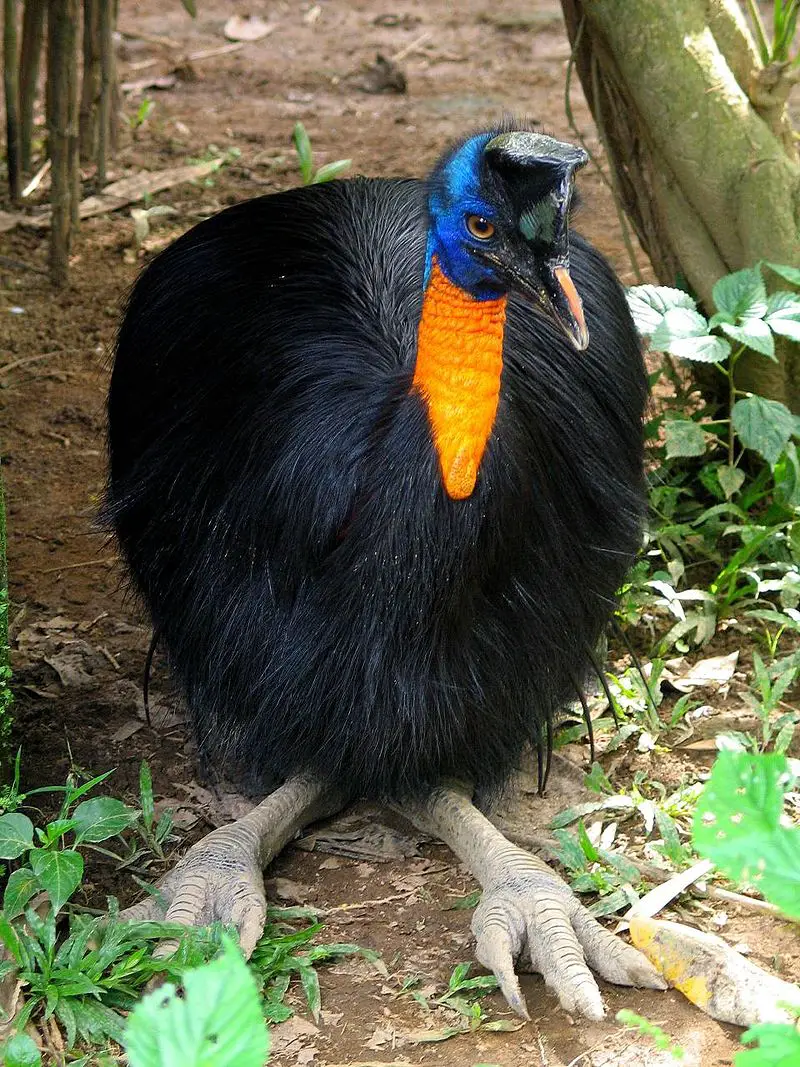
The Northern Cassowary is a large, flightless bird that inhabits the forests of northern New Guinea. It was first discovered by Edward Blyth in 1878 and belongs to the superorder Paleognathae.
This species has an unmistakable appearance with its black plumage, vibrant blue neck wattles and bright yellow casque atop its head.
The cassowary can reach up to 1.5 metres tall and weigh between 20-50 kgs depending on their age and gender; it is also one of the most dangerous birds due to powerful legs equipped with long claws used for defence against predators or challengers.
They feed mostly on fruits but will consume small animals such as lizards if presented another food source becomes scarce – making them omnivores overall.
Despite its somewhat intimidating size, this remarkable bird plays an essential role within its ecosystem providing vital services like seed dispersal which allows plants to spread throughout new regions & aiding in nutrient cycling through decomposing animal matter from decaying fruit they eat helping maintain healthy soil quality.Scientific classification:
| Kingdom | Animalia |
| Phylum | Chordata |
| Class | Aves |
| Infraclass | Palaeognathae |
| Order | Casuariiformes |
| Family | Casuariidae |
| Genus | Casuarius |
| Species | C. unappendiculatus |
Also Featured In: Papua New Guinea birds, Birds Typically Found in Australian Rainforest
25. Grey Parrot
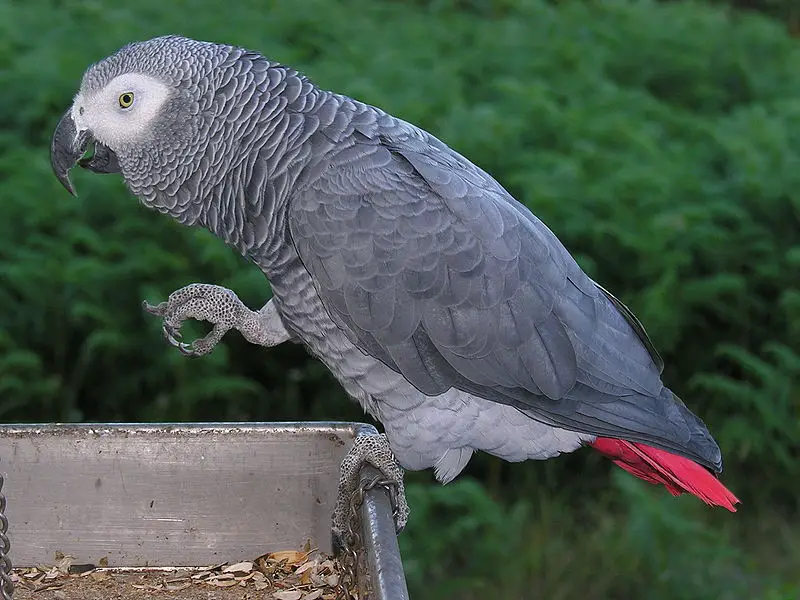
The Grey Parrot, also known as the Congo grey parrot, is a species of Old World parrots belonging to the family Psittacidae.
It was formally described by Swedish naturalist Carl Linnaeus in 1758.
This bird has an ash-grey plumage with bright red tail feathers and white markings around its eyes and beak.
They are very intelligent birds that can mimic human speech and understand basic commands.
Their diet consists mainly of fruits, nuts, seeds, vegetables and insects found in their native African habitat or other tropical regions they inhabit such as rainforests or woodlands.
Grey parrots have become popular pets due to their intelligence and ability to learn complex behaviors like talking back when spoken too.Scientific classification:
| Kingdom | Animalia |
| Phylum | Chordata |
| Class | Aves |
| Order | Psittaciformes |
| Family | Psittacidae |
| Genus | Psittacus |
| Species | P. erithacus |
Also Featured In: Congo Birds, Aviary Birds You Should Know
26. Spectacled Owl
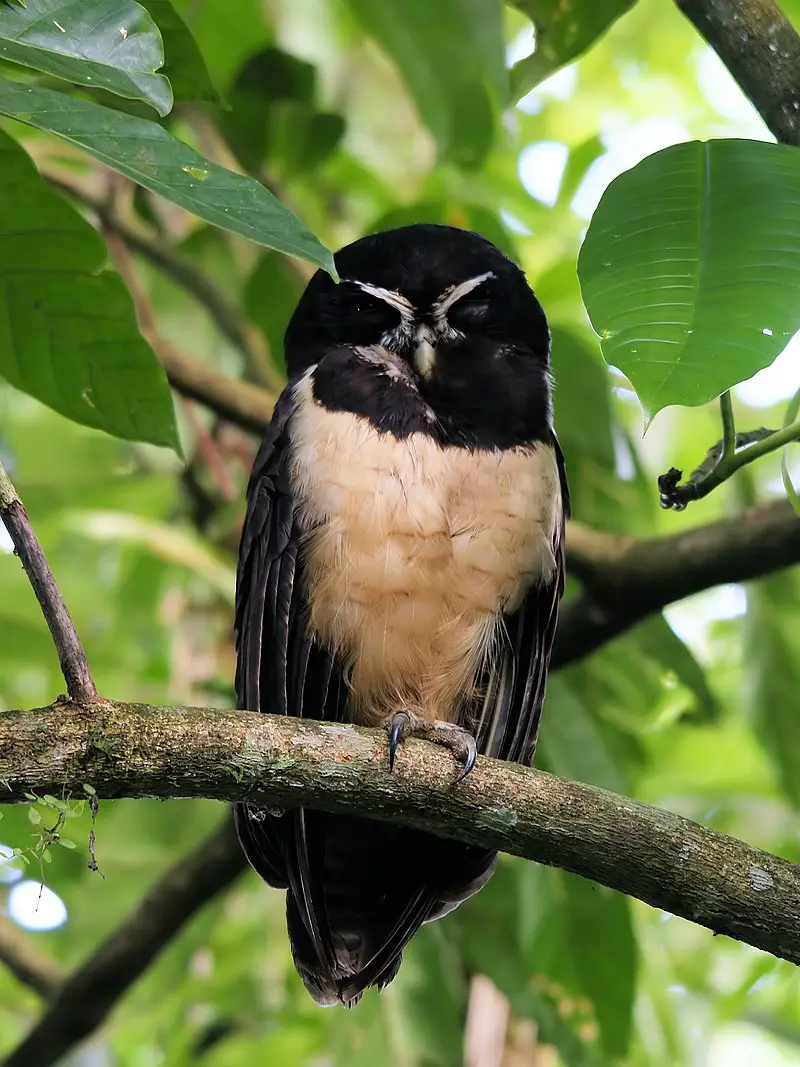
The Spectacled Owl is a large tropical owl that breeds in forests from southern Mexico, Trinidad and Central American countries to Southern Brazil, Paraguay and Argentina.
It has six subspecies with one of them sometimes considered as a separate species called the Short-Browed or Brown Spectacled Owl.
The bird’s body is covered by an array of feathers which are typically dark brown streaked with lighter shades marking its eyes like spectacles; this gives it its name.
Its call could be described as a series of hoots followed by shrieks making it easily distinguishable amongst other owls.
This nocturnal predator feeds mostly on small mammals such as mice while larger prey items include frogs, bats and even birds.Scientific classification:
| Kingdom | Animalia |
| Phylum | Chordata |
| Class | Aves |
| Order | Strigiformes |
| Family | Strigidae |
| Genus | Pulsatrix |
| Species | P. perspicillata |
Also Featured In: Panama Birds,
27. Green Honeycreeper
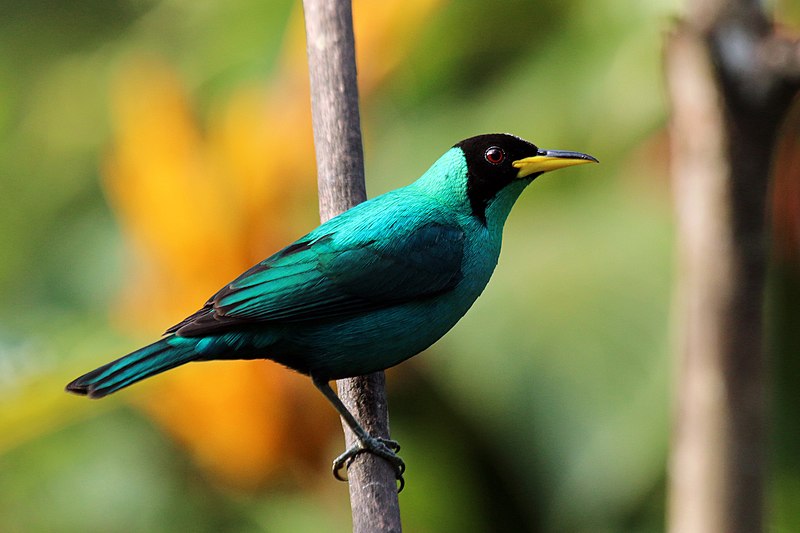
The Green Honeycreeper is a vibrant and colorful bird of the tanager family. It can be found in tropical parts of Mexico, Central America and South America up to Brazil.
This species was first formally described by Swedish naturalist Carl Linnaeus in 1758 under its current name Mota.
The bright green plumage gives it an attractive look making them popular among ornithologists and nature lovers alike.
They mainly feed on nectar from flowers as well as small insects which they catch while flying or hopping around trees and shrubs near forest edges.
These birds are known for their melodious songs often heard during mating season when males sing to attract females – a trait that helps make these birds so captivating.Scientific classification:
| Kingdom | Animalia |
| Phylum | Chordata |
| Class | Aves |
| Order | Passeriformes |
| Family | Thraupidae |
| Genus | Chlorophanes Reichenbach, 1853 |
| Species | C. spiza |
Also Featured In: birds of green birds, Rainforest Birds You Should Know
28. True Macaws

True macaws are a diverse group of parrots belonging to the genus Ara. These colorful birds are found in the Neotropics and are known for their large size and striking plumage.
There are eight extant species of True macaws, each with their own unique colors and patterns.
The genus name Ara was coined in 1799 by French naturalist Bernard Germain de Lacépède and is derived from the Tupi word ará, which is the onomatopoeia for the sound a macaw makes.
True macaws are part of the Arini tribe of neotropical parrots and are highly prized in the pet trade for their beauty and intelligence.
However, many True macaw species are also endangered due to habitat loss and poaching, making conservation efforts crucial for their survival.Scientific classification:
| Kingdom | Animalia |
| Phylum | Chordata |
| Class | Aves |
| Order | Psittaciformes |
| Family | Psittacidae |
| Tribe | Arini |
| Genus | Ara Lacépède, 1799 |
Also Featured In: Birds That Live in the Jungle,
29. Cassowaries
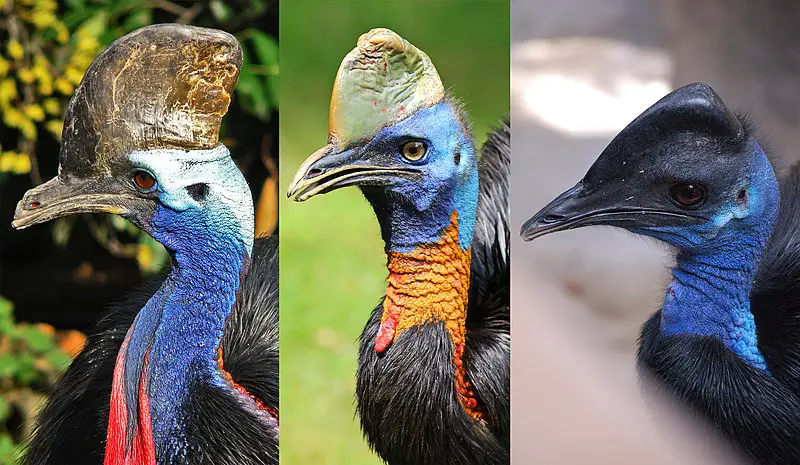
Cassowaries are unique, flightless birds belonging to the genus Casuarius. They are classified as ratites, and they do not have a keel on their sternum bones.
These fascinating birds are found in the tropical forests of New Guinea, Aru Islands, and northeastern Australia. Three species of cassowaries still exist, with the most prevalent being the Southern cassowary.
They are known for their crest, which protrudes from their heads, and their bright blue skin on their neck and head.
Cassowaries are also known for their sharp talons that can grow up to 12 centimeters long, and they can jump up to 1.5 meters high.
Cassowaries are often described as being dangerous as they have been known to attack humans when provoked, but they also play a vital role in their ecosystem as seed dispersers.Scientific classification:
| Kingdom | Animalia |
| Phylum | Chordata |
| Class | Aves |
| Infraclass | Palaeognathae |
| Order | Casuariiformes |
| Family | Casuariidae Kaup, 1847[1] |
| Genus | Casuarius Brisson, 1760 |
Also Featured In: Birds You’ll Find in Zoo, Most Common Nature Birds
30. Cock-Of-The-Rock
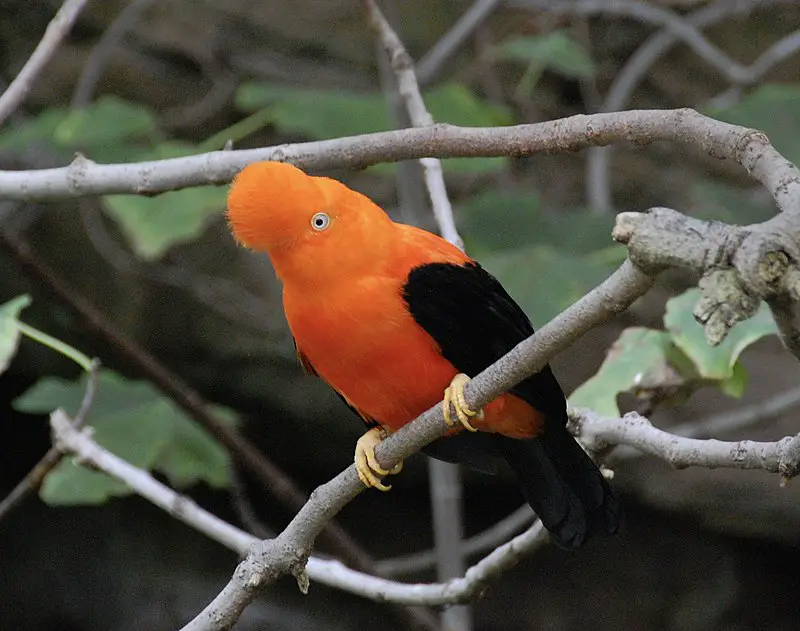
Cock-of-the-rock birds belong to the Rupicola genus and are found in South America. They are large and are part of the cotingid family. These birds usually live in rainforests and are generally found close to rocky areas.
This is also where they build their nests. The species were first documented in the mid-1700s during a research expedition.
The Cock-of-the-rock is known for its unique appearance, with males having bright orange heads and chests.
They are popular among bird watchers and are often featured in nature documentaries. Due to habitat loss and hunting, the population of these birds is decreasing.
Conservation efforts are being made to protect them and their natural habitat.Scientific classification:
| Kingdom | Animalia |
| Phylum | Chordata |
| Class | Aves |
| Order | Passeriformes |
| Family | Cotingidae |
| Genus | Rupicola Brisson, 1760 |
31. Crimson Topaz
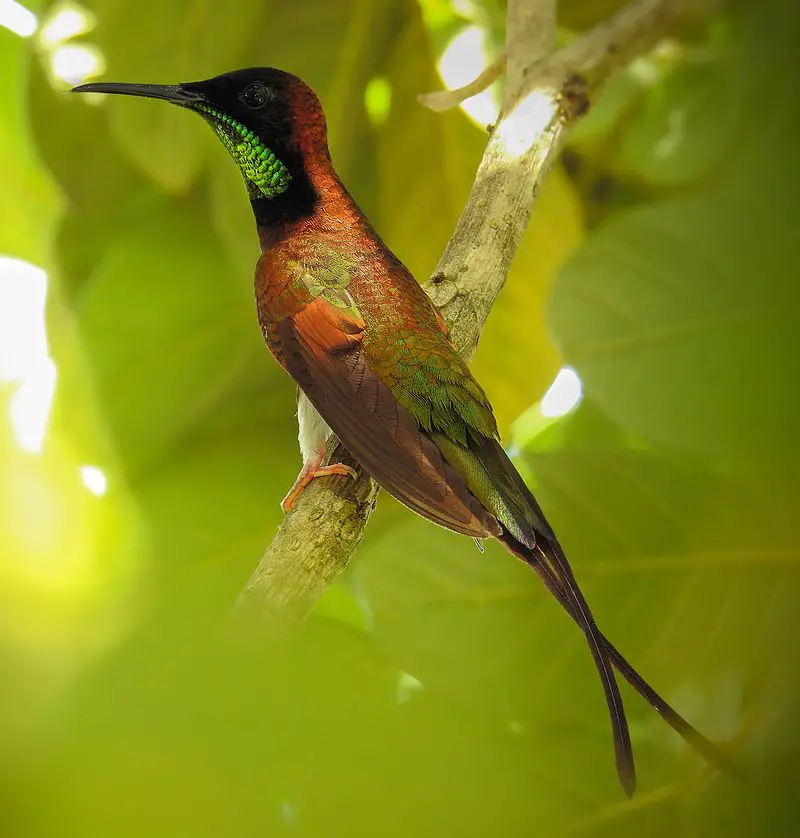
The Crimson Topaz bird, scientifically known as Topaza pella, is a beautiful species of hummingbird found in the tropical regions of Brazil, French Guiana, Guyana, Suriname, and Venezuela.
This bird was first identified and classified by the famous Swedish naturalist, Carl Linnaeus in 1758.
The Crimson Topaz is known for its vibrant red plumage, long tail feathers, and ability to hover in mid-air whilst feeding on nectar from flowers.
It is a popular species amongst birdwatchers and photographers due to its bright, eye-catching appearance.
Despite its small size, the Crimson Topaz plays an important role in pollinating flowers and sustaining the biodiversity in its native habitats.
It is truly a spectacular bird to observe in flight amidst the lush, tropical landscape.Scientific classification:
| Kingdom | Animalia |
| Phylum | Chordata |
| Class | Aves |
| Clade | Strisores |
| Order | Apodiformes |
| Family | Trochilidae |
| Genus | Topaza |
| Species | T. pella |
32. Curl-Crested Aracari
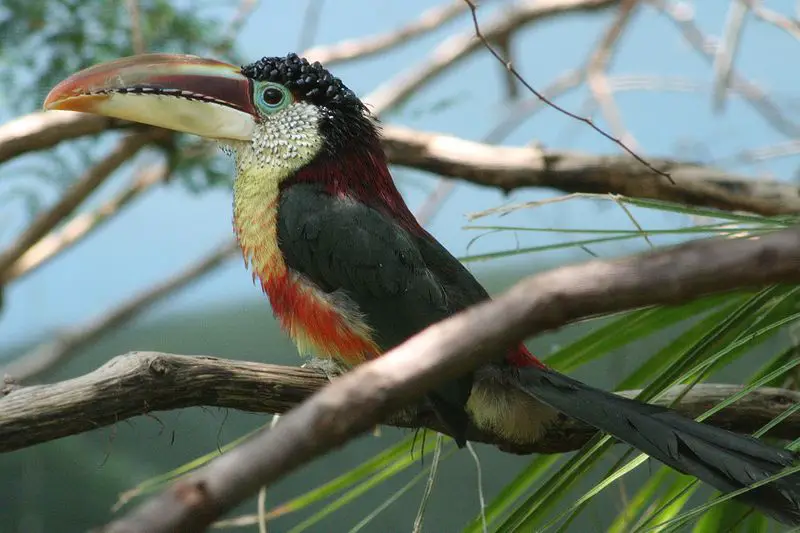
The Curl-crested aracari is a bird species belonging to the toucan family found in Peru, Bolivia and Brazil. Johann Georg Wagler first described it in 1831.
It had been incorrectly named for many years, and the correct name was only established in 2020. The bird is also known as the Curl-crested Araçari and is considered a near-passerine species.
It has been placed in the monotypic genera Beauhar in the past. The bird’s distinctive feature is its curled crest, which gives it a unique appearance.Scientific classification:
| Kingdom | Animalia |
| Phylum | Chordata |
| Class | Aves |
| Order | Piciformes |
| Family | Ramphastidae |
| Genus | Pteroglossus |
| Species | P. beauharnaisii |
33. Paradise Tanager
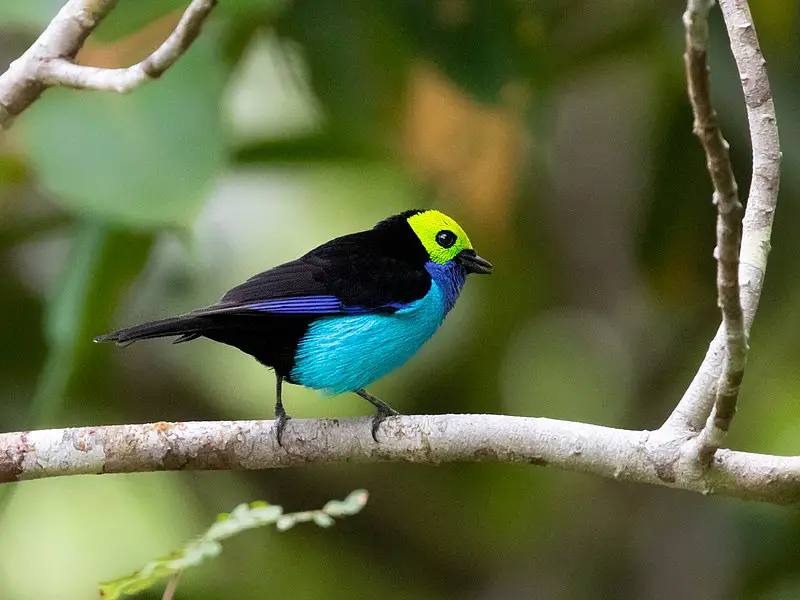
The Paradise tanager is a strikingly beautiful bird, known for its vibrant, multicolored plumage. This medium-sized songbird measures between 13.5 and 15 cm in length and has a light green head, complemented by sky blue underparts and black upper-body feathers.
This Amazon rainforest native’s behind is either yellow and red or all red. The bird’s black beak and grey legs are in sharp contrast with its colorful body.
The Paradise tanager is typically found in humid tropical and subtropical regions. Its bright colors help it blend in with the vibrant foliage of the rainforest canopy.
The bird is a veritable icon of the Amazon and an inspiring example of nature’s vibrant beauty.Scientific classification:
| Kingdom | Animalia |
| Phylum | Chordata |
| Class | Aves |
| Order | Passeriformes |
| Family | Thraupidae |
| Genus | Tangara |
| Species | T. chilensis |
34. Cobalt-Winged Parakeet
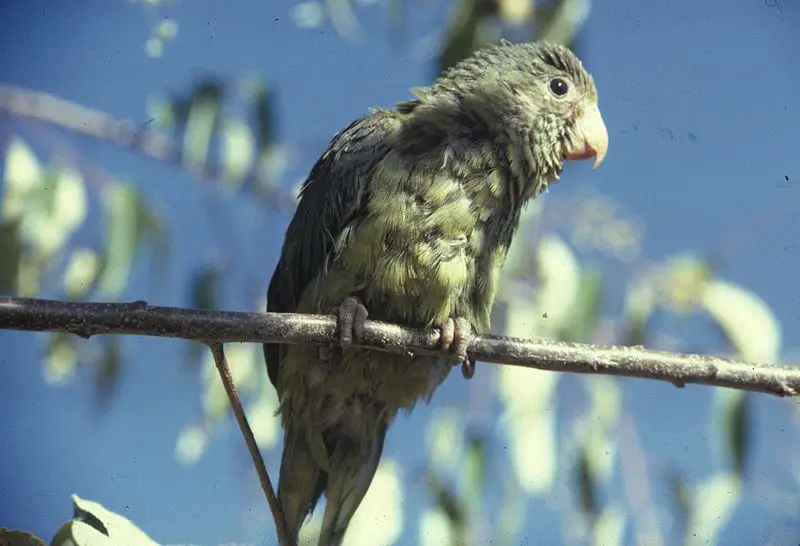
The Cobalt-winged Parakeet is a species of bird that belongs to the family Psittacidae. It can be found in several South American countries including Bolivia, Brazil, Colombia, Ecuador, Guyana, Peru, and Venezuela.
This species is known for its bright and beautiful blue wings, which are what give it its name. August von Pelzeln was credited with the first description of this parakeet species.
While not a particularly large bird, the Cobalt-winged Parakeet is still a beloved species among bird enthusiasts for its striking appearance and unique personality.
Its natural habitat consists of forests and woodlands, where it feeds on fruits, nuts, and seeds. With its vivid blue hues and charming behavior, the Cobalt-winged Parakeet is a treat to both see and hear.Scientific classification:
| Kingdom | Animalia |
| Phylum | Chordata |
| Class | Aves |
| Order | Psittaciformes |
| Family | Psittacidae |
| Genus | Brotogeris |
| Species | B. cyanoptera |
35. Bluish-Fronted Jacamar
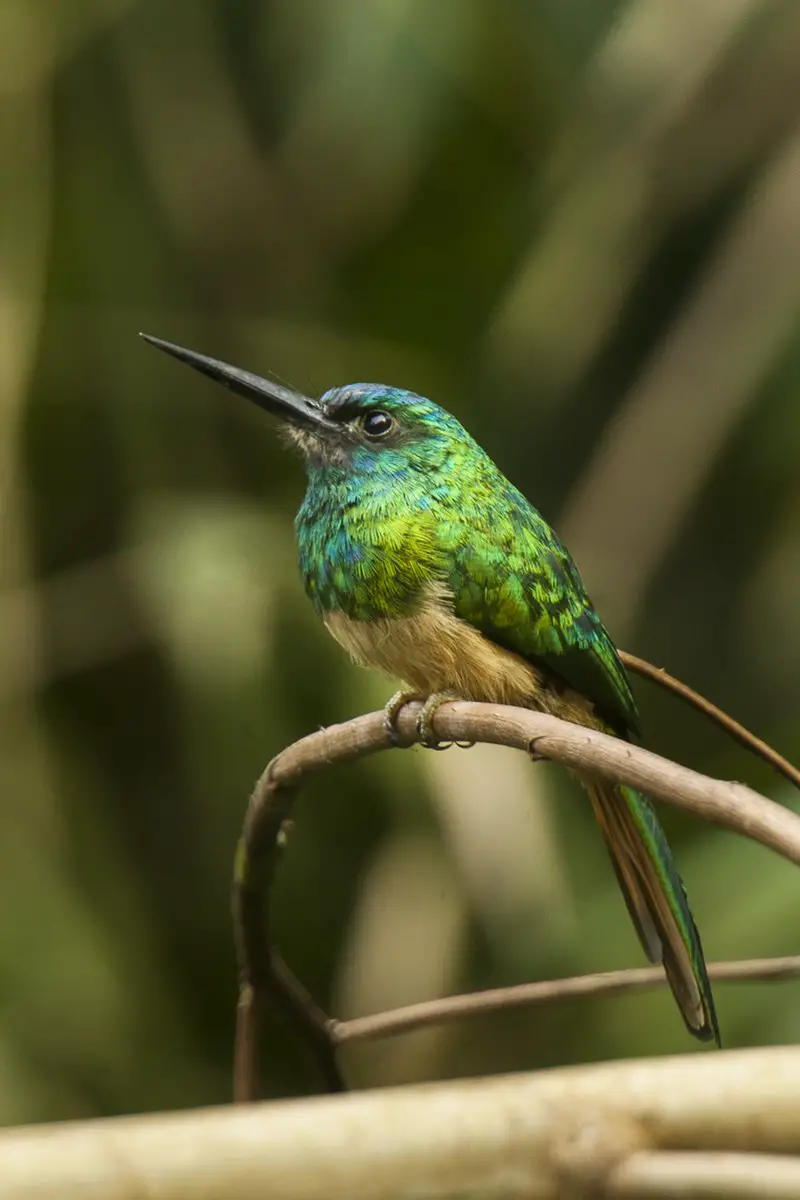
The bluish-fronted jacamar is a unique species of bird from the Galbulidae family. It can be found in Bolivia, Brazil, and Peru. This bird is the only one in its genus, making it monotypic.
It is also a part of a superspecies that includes rufous-tailed, white-chinned, coppery-chested, and green-tailed jacamars.
As the name suggests, the bluish-fronted jacamar has a distinct blue-colored frontal that makes it easily identifiable.
It is a small-sized bird with a long, pointed beak that it uses to catch insects in mid-air. Its striking appearance and impressive hunting skills make it a favorite subject for birdwatchers and nature enthusiasts.
The conservation status of this bird remains stable, and it continues to thrive in its natural habitat.Scientific classification:
| Kingdom | Animalia |
| Phylum | Chordata |
| Class | Aves |
| Order | Piciformes |
| Family | Galbulidae |
| Genus | Galbula |
| Species | G. cyanescens |
36. Afep Pigeon
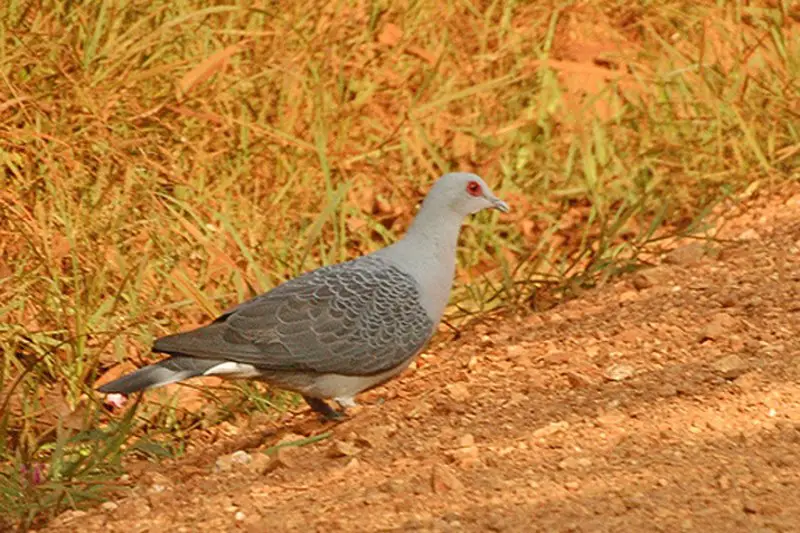
The Afep pigeon, also known as the African wood-pigeon or gray wood-pigeon, is a species of bird that can be found in the Equatorial Forests of Africa.
This bird was first described by the American ornithologist John Cassin in 1860, after he collected a specimen from the Ogooué River in Gabon.
The scientific name given to this pigeon is Columba unicincta. The Afep pigeon belongs to the family Columbidae and is known for its gray coloration.
They are known to live in the dense forest areas and feed on fruits and seeds found on the forest floor. These pigeons can grow up to a length of 41 cm and have a wingspan of 72 cm.
The Afep pigeon is a beautiful and important part of the ecosystem in the Equatorial Forests.Scientific classification:
| Kingdom | Animalia |
| Phylum | Chordata |
| Class | Aves |
| Order | Columbiformes |
| Family | Columbidae |
| Genus | Columba |
| Species | C. unicincta |
Also Featured In: African Rainforest Birds,
37. Lemon-Bellied Crombec
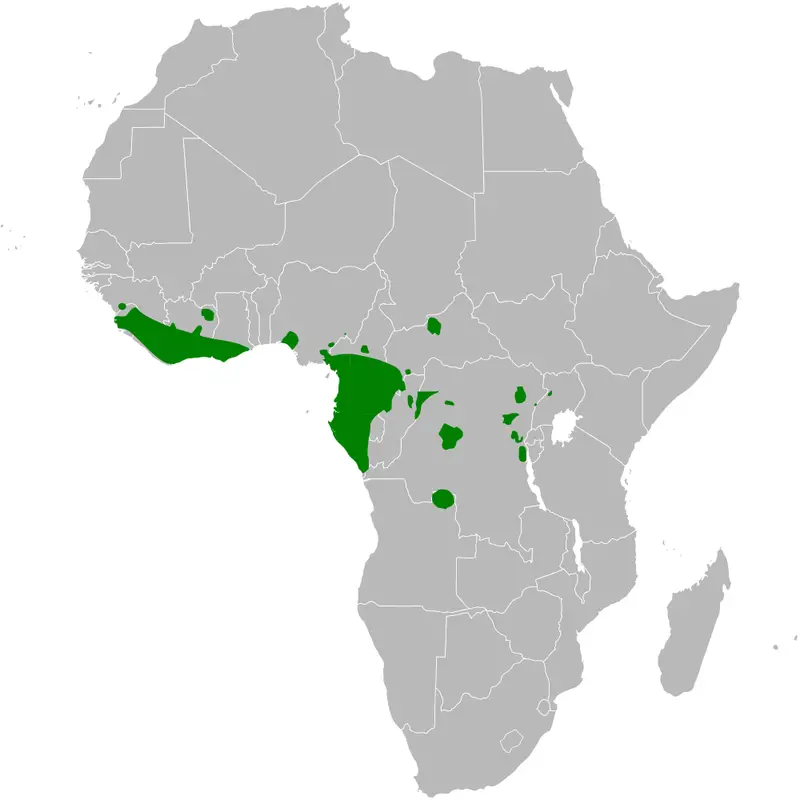
The Lemon-bellied Crombec is an African warbler that used to be classified under the Sylviidae family.
These birds can be found in areas with tropical or subtropical moist shrublands and lowland forests throughout the African continent.
They have a lemon-colored belly, hence their name, and are sparsely present in the tropical rainforests of Africa.
These birds are the most active during the breeding season, with both male and female birds sharing the responsibility of building the nest.
They are known for their unique and melodious songs that can be heard from a distance. Their diet primarily consists of insects and arthropods, which they catch by hovering and darting through the foliage.
The Lemon-bellied Crombec is a beautiful bird that adds to the colorful biodiversity of the African continent.Scientific classification:
| Kingdom | Animalia |
| Phylum | Chordata |
| Class | Aves |
| Order | Passeriformes |
| Family | Macrosphenidae |
| Genus | Sylvietta |
| Species | S. denti |
38. Sabine’s Puffback
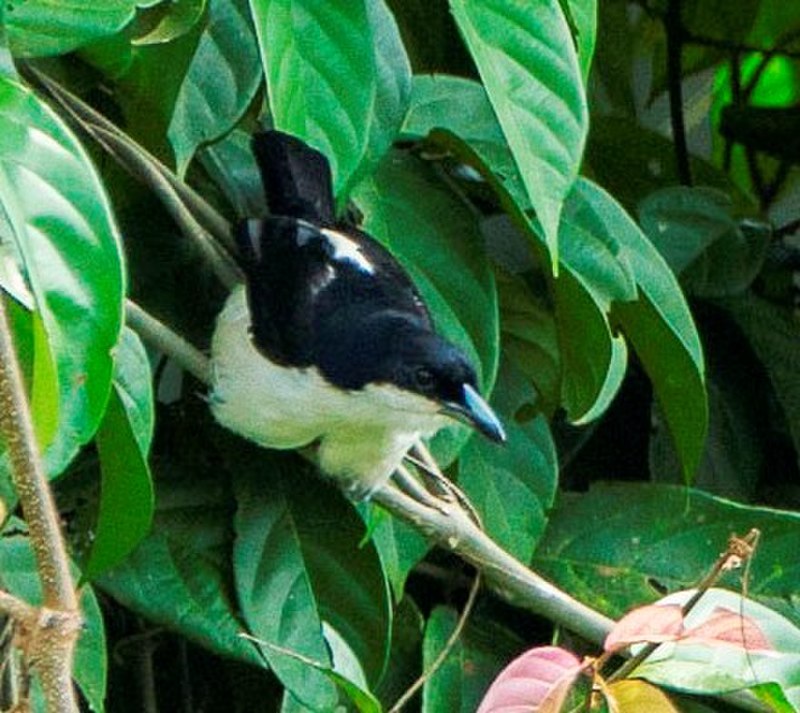
Sabine’s puffback is a type of bird belonging to Malaconotidae family. Indigenous to African tropical rainforests, these birds are found in Western and Central Africa.
These birds are mostly seen in moist lowland forests or swamps. They are also known as the large-billed puffback, and their scientific name is Dryoscopus sabini. The name of these birds is in commemoration of Sabine, the bird collector.
The Sabine’s puffback bird is a unique species that has distinct large bill and enjoys the tropical climate. They are fascinating creatures that attract bird enthusiasts worldwide.Scientific classification:
| Kingdom | Animalia |
| Phylum | Chordata |
| Class | Aves |
| Order | Passeriformes |
| Family | Malaconotidae |
| Genus | Dryoscopus |
| Species | D. sabini |
39. Dusky Crested Flycatcher
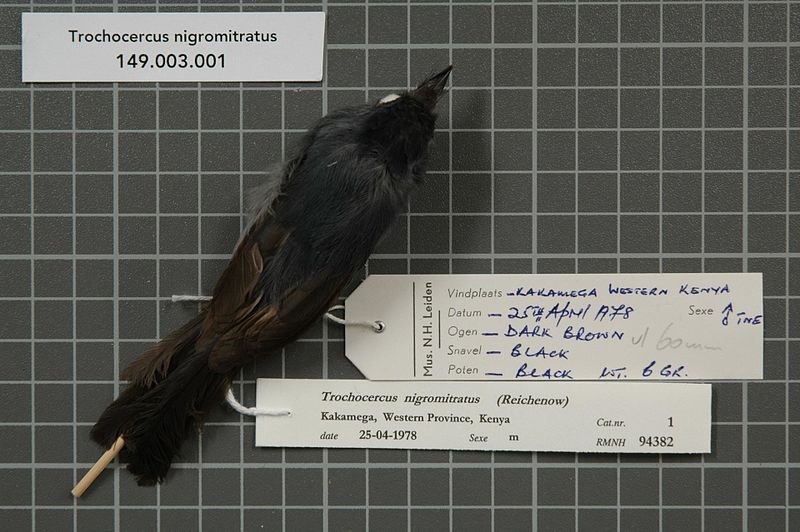
The Dusky crested flycatcher is a bird species found in African rainforests. They are members of the Stenostiridae family and are commonly found in subtropical or tropical moist lowland and montane forests.
The bird’s scientific name is Elminia nigromitrata. The bird’s body is characterized by a dusky grey color and a distinctive crest on top of the head, which gives it a distinct appearance.
The Dusky crested flycatcher bird is known to feed on insects while hunting from a perch, and they can also take insects while in flight.
They are common in many areas of Africa, and their status is not currently considered at risk.
Overall, Dusky crested flycatchers are fascinating birds to observe in their natural habitats.Scientific classification:
| Kingdom | Animalia |
| Phylum | Chordata |
| Class | Aves |
| Order | Passeriformes |
| Family | Stenostiridae |
| Genus | Elminia |
| Species | E. nigromitrata |
40. Fiery-Breasted Bushshrike
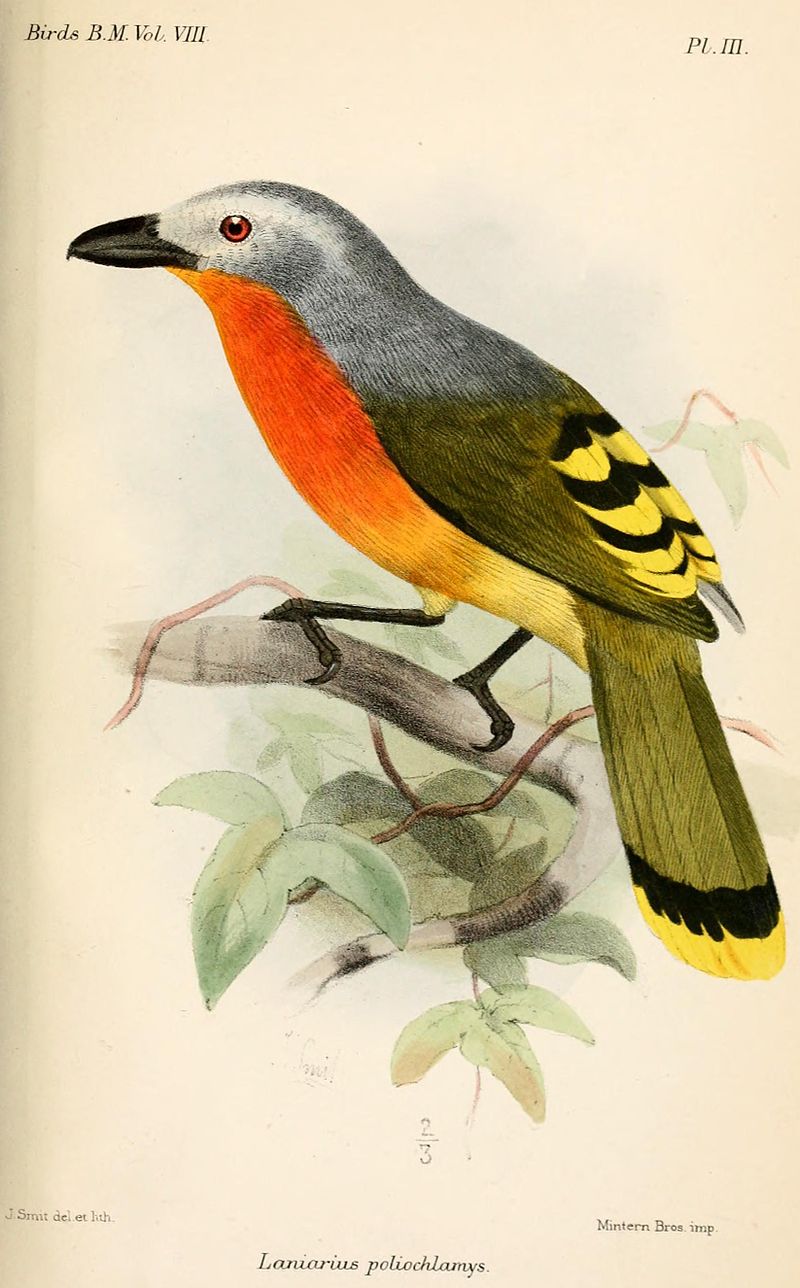
The fiery-breasted bushshrike, a member of the Malaconotidae family, can be found across the African tropical rainforest.
This bird species prefers to live in areas with subtropical or tropical dry forests as well as moist lowland forests.
With its unique fiery breast pattern, this bushshrike is known for its distinguishable appearance.
They are small but emit a melodic call that can be heard echoing through the forest. Seen as top predators in their habitats, these birds feed on insects and small animals.
Due to deforestation and habitat loss, the fiery-breasted bushshrike population has been declining.
Despite this, they remain one of the many special bird species that call the African tropical rainforest home.Scientific classification:
| Kingdom | Animalia |
| Phylum | Chordata |
| Class | Aves |
| Order | Passeriformes |
| Family | Malaconotidae |
| Genus | Malaconotus |
| Species | M. cruentus |
41. Olivaceous Flycatcher
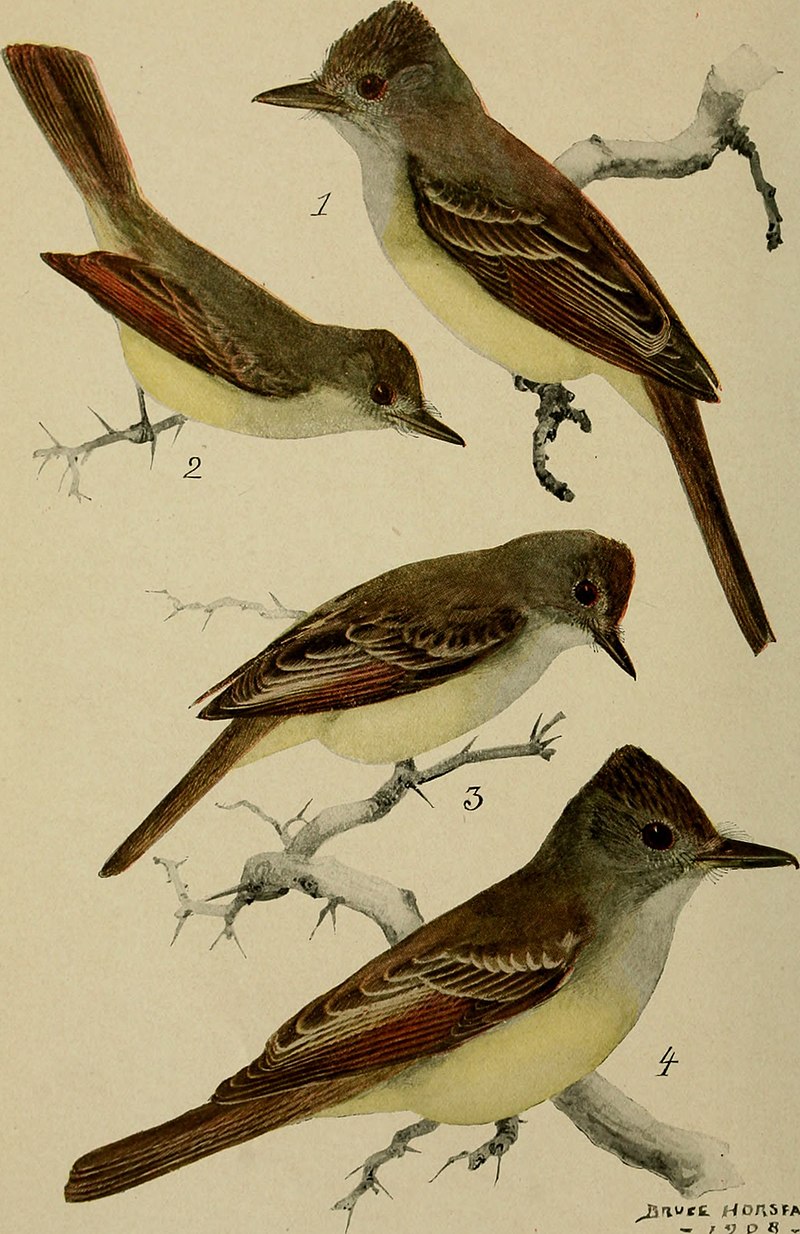
The Olivaceous flycatcher bird, also known as the olivaceous alseonax, belongs to the Muscicapidae family.
It is located in the African tropical rainforest and can be found in subtropical or tropical moist lowland forests and swamps.
This species has sparse distribution throughout its habitat. The bird is a small passerine bird with brownish-gray feathers, and it mainly feeds on insects, particularly flies.
Its unique characteristic is its ability to hunt its prey by perching on tree branches and rapidly flying out to catch insects mid-air.
These birds are not common to find, but when spotted, they are an exquisite sight to see.
Due to its scarce distribution, the Olivaceous flycatcher bird is not listed as an endangered species; however, habitat destruction and deforestation pose a potential threat to this species in the future.Scientific classification:
| Kingdom | Animalia |
| Phylum | Chordata |
| Class | Aves |
| Order | Passeriformes |
| Family | Muscicapidae |
| Genus | Muscicapa |
| Species | M. olivascens |
42. Yellow-Mantled Weaver
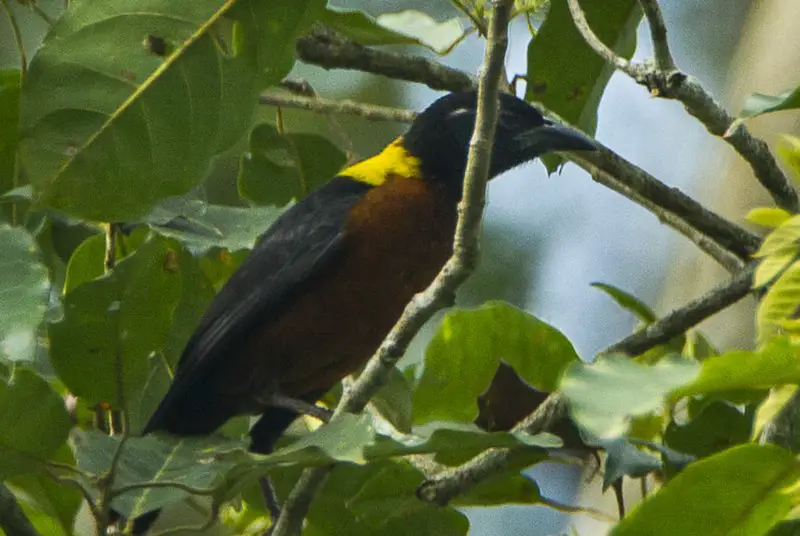
The Yellow-mantled weaver is a bird that belongs to the Ploceidae family. This species is known for its sparse distribution across the African tropical rainforest.
They have a unique yellow mantle, or patch of feathers, which distinguishes them from other weavers.
The Yellow-mantled weaver is a skilled builder of elaborate nests, which they weave with blades of grass or other plant material.
They usually build their nests in a tree or bush, hanging them from a branch. The male Yellow-mantled weaver is known for its bright, colorful plumage during the mating season, which it uses to attract a female mate.
This bird is considered a treasure of African biodiversity and can be spotted in the wild by keen birdwatchers.Scientific classification:
| Kingdom | Animalia |
| Phylum | Chordata |
| Class | Aves |
| Order | Passeriformes |
| Family | Ploceidae |
| Genus | Ploceus |
| Species | P. tricolor |
43. White-Crowned Hornbill
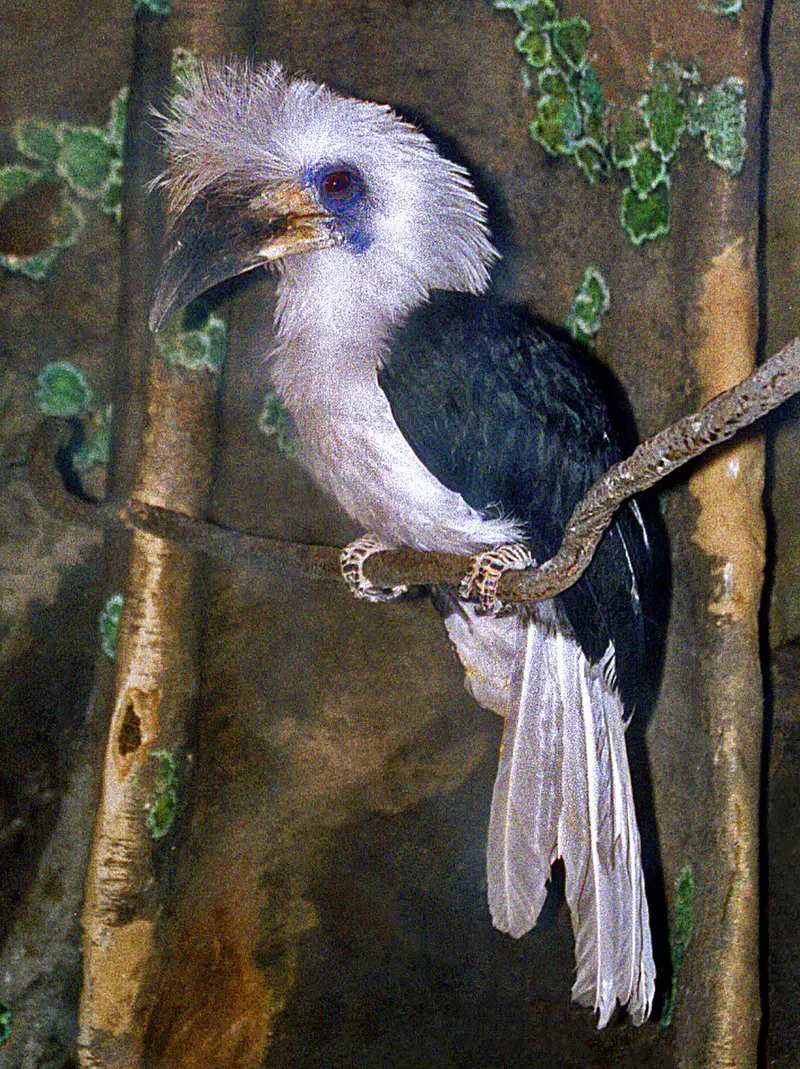
The white-crowned hornbill is a unique species of hornbill. It is also referred to as the long-crested or white-crested hornbill, which can be easily confused with a similar African species.
It belongs to the Berenicornis genus, which may also include the white-crested hornbill. However, it is sometimes placed in the Acero genus.
This bird features an iconic white crown and is monotypic, meaning it belongs to a single species within its genus.
The white-crowned hornbill has a distinctive appearance and is an interesting bird to observe in its natural habitat.Scientific classification:
| Kingdom | Animalia |
| Phylum | Chordata |
| Class | Aves |
| Order | Bucerotiformes |
| Family | Bucerotidae |
| Genus | Berenicornis Bonaparte, 1850 |
| Species | B. comatus |
Also Featured In: Birds that Live in Borneo Island,